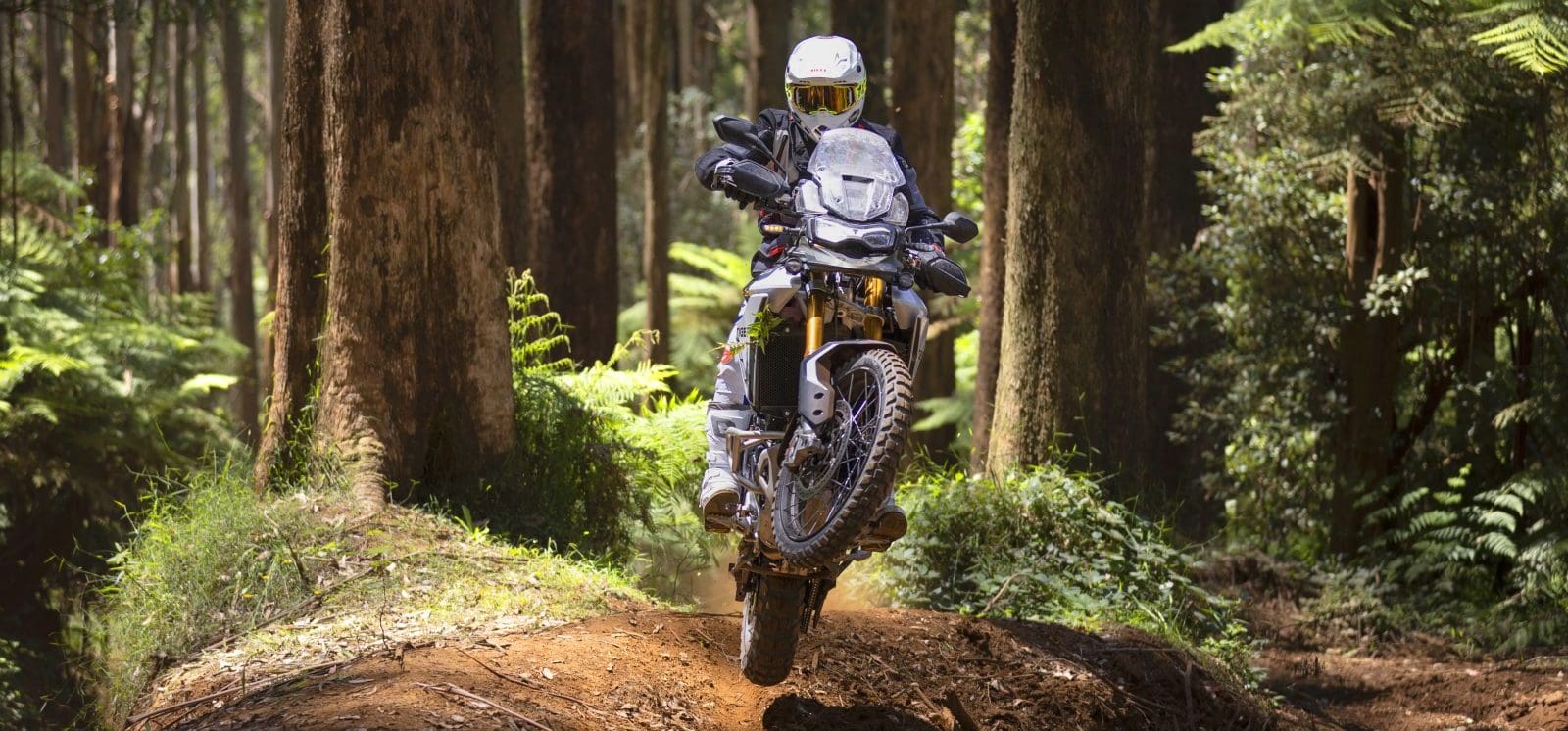There are some standout events throughout the year that the AMCN crew really looks forward to, and one of those is our annual adventure issue and the bike test that goes with it. After all, what could be better than going riding with mates, getting some dirt under your wheels and enjoying a couple of nights in the scrub? In the past we have sometimes treated the AMCN adventure bike test as an opportunity to compare bikes directly with each other, but this year we decided to showcase a cross section of models from the genre to see how well they spoke to a variety of riders through some vigorous (and fun) testing both on- and off-road. While we had seven worthy bikes on test, there were a few notable omissions, largely due to timing and testbike availability, but we will get to those models in the not-too-distant future. In the meantime, enjoy the ride…

HOW WE DID THIS
On our last couple of adventure tests, we headed off to some far-flung parts usually around the New South Wales and Victoria border to keep the Mexican crew happy. But with no Victorians in attendance this year we decided to head west to Hill End in New South Wales’ Central Tablelands, a prime location much closer to home and one of the state’s most popular adventure bike locations.
The advantage of having a destination just a couple of hundred kilometres away is that we could use what would otherwise be travel time as off-road testing time, and our intended route had plenty of that.
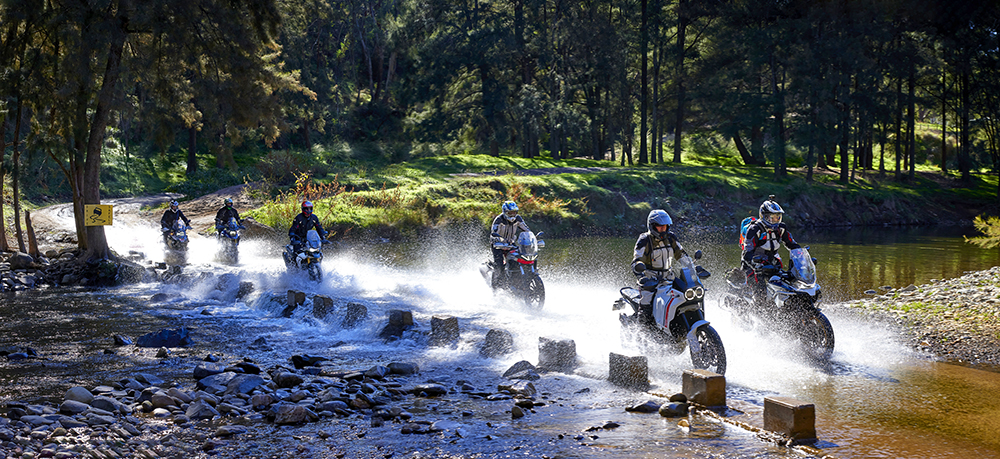
Our planned route took the seven of us from our respective bases in Sydney and surrounds over the Blue Mountains via Bells Line of Road before hanging a right onto dirt at the refurbished Zigzag Railway and popping out beyond Lithgow after navigating Black Fellows Hand trail. From there it was on to Sofala via the freshly graded Turon Gates Road and then on to Hill End where we’d stay the next two nights.

Day two had us exploring the historic and natural beauty around Hill End with a plan to head home via the recently reopened Bridle Track on the third and final day. The trip didn’t go quite to plan thanks to snapper Josh who got us hopelessly lost – again! See AMCN Vol 69 No 09 – above Lithgow somewhere on the first day, which meant we soaked up the epic Bridle Track on day two and headed home to Sydney via Turon Gates Road on day three instead.
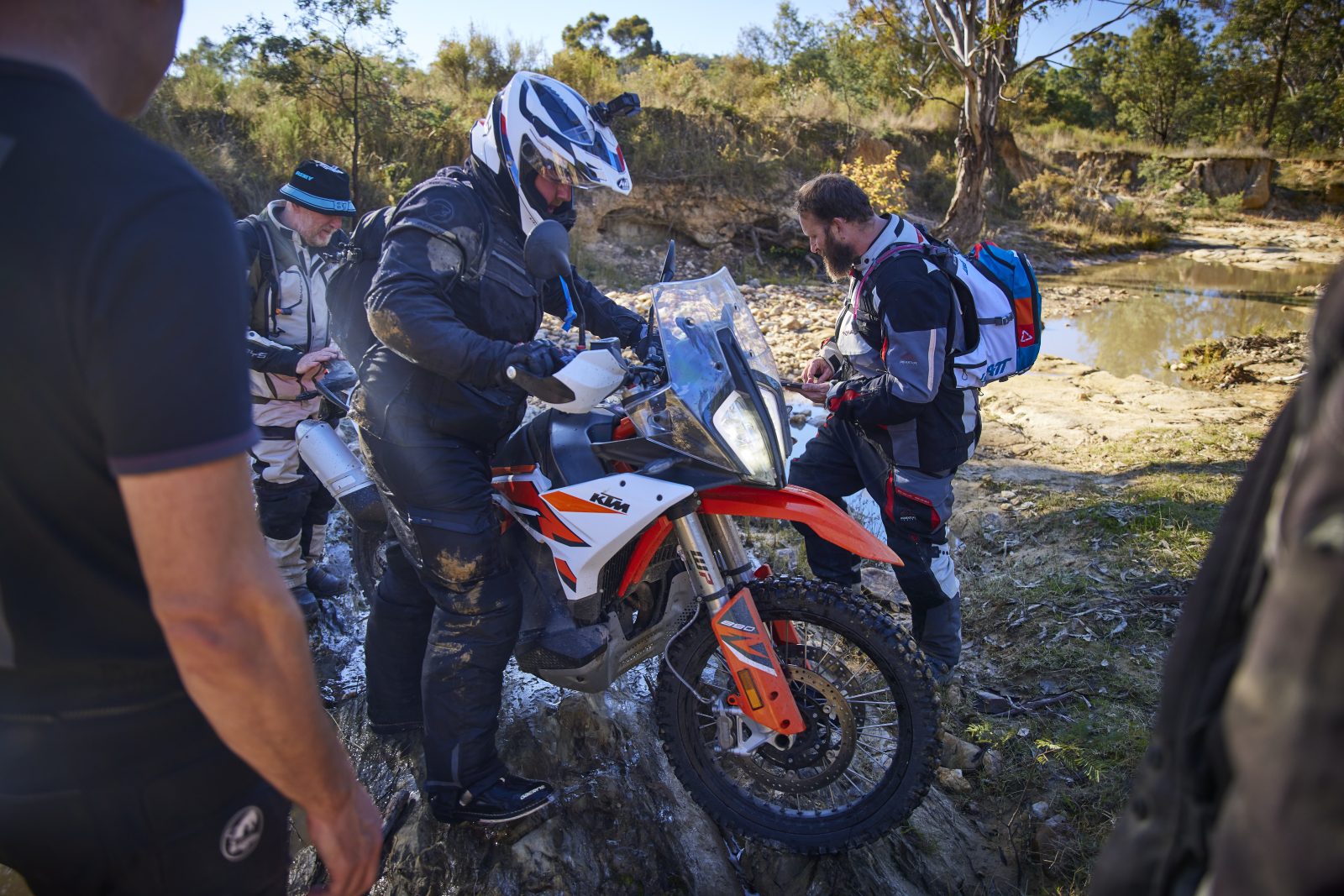
We ended up with seven bikes for this year’s adventure test – but that is just a whiff of what’s available. The seven bikes were Aprilia’s Tuareg 660, BMW’s segment-defining R 1250 GS, CFMoto’s recently released 800MT Explore, KTM’s updated 2023 890 Adventure R, Suzuki’s new dirt-focused V-Strom 1050DE, and Triumph’s triple-cylinder Tiger 900 Rally Pro. We haven’t run this test as a direct comparison, as the specifications and abilities of the bikes on- and off-road vary significantly. Pricing is less variable, with most of the bikes carrying a price tag in the low to mid $20k region. The group is bookended by the $16,490 ride away 800MT Explore and the R 1250 GS at $27,640, but in the Trophy guise tested here the big Beemer will set you back around $35k.
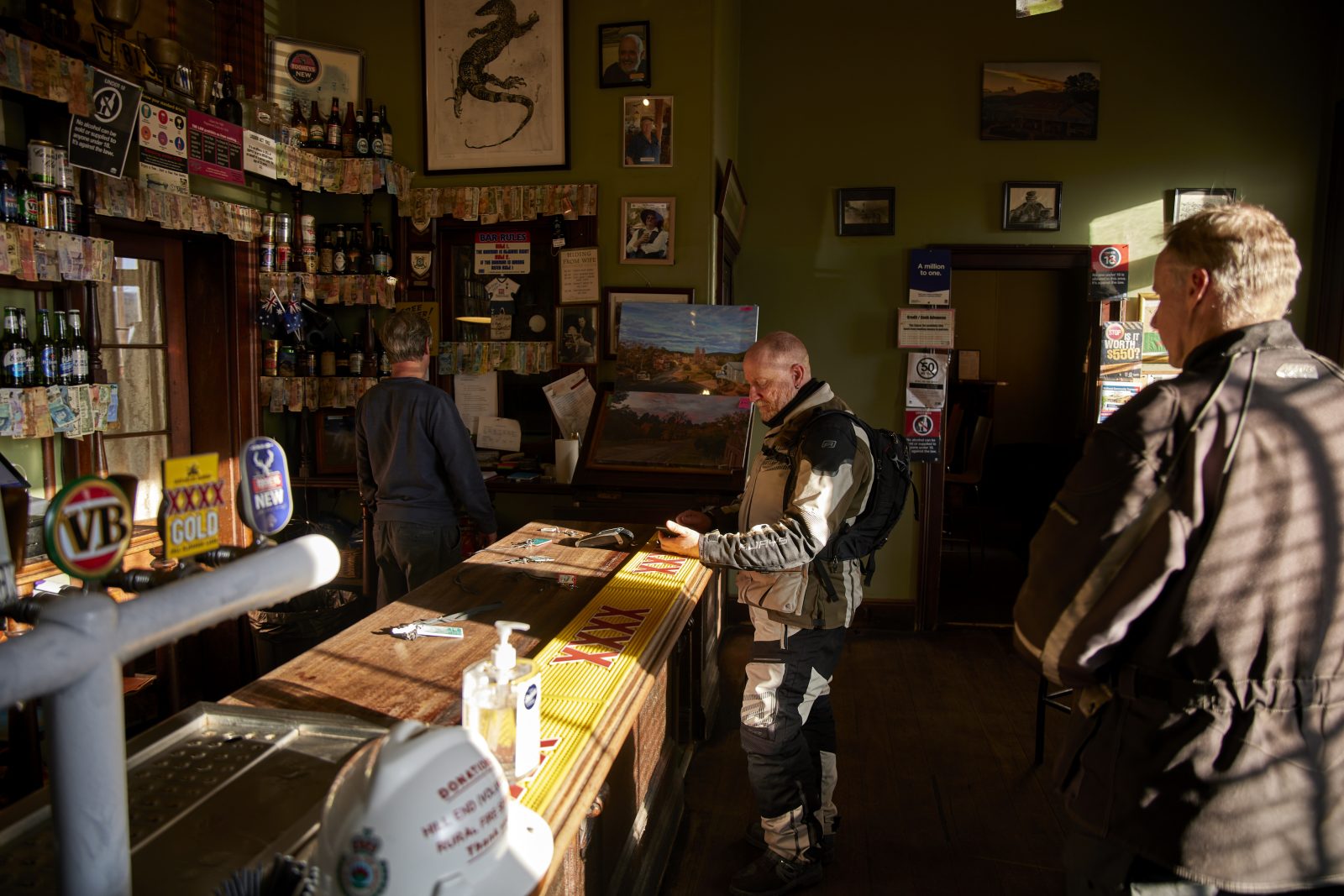
Our wishlist was vast and included bikes such as the Adventure-spec R 1250 GS and F 850 GS, Harley’s Pan America, Honda’s Africa Twin, KTM’s 1290 Super Adventure R and Triumph’s Tiger 1200 Rally and Rally Pro. There is also a bunch of new metal due to arrive in the coming months that we would loved to have had on test. Ducati’s new Multistrada V4 Rally was high on the list as was Benelli’s TRK 800, Honda’s reborn Transalp, Suzuki’s fresh V-Strom 800 DE and Husqvarna’s Norden 901 Expedition, along with Yammie’s Ténéré 700 World Raid. Of course, we didn’t have access to all these models, and nor do we have unlimited resources, but we reckon our group of seven is a bona fide cross section of the mid-to large-size adventure market.

We rode some of the best and most picturesque adventure bike roads and tracks NSW has to offer on this trip.
A couple of bikes toppled over at low speeds – nobody was injured and nothing was broken – there were plenty of laughs and a top evening spent around a campfire with mates, a couple of sherberts, and seven of the best adventure bikes money can buy. It really doesn’t get much better than this.
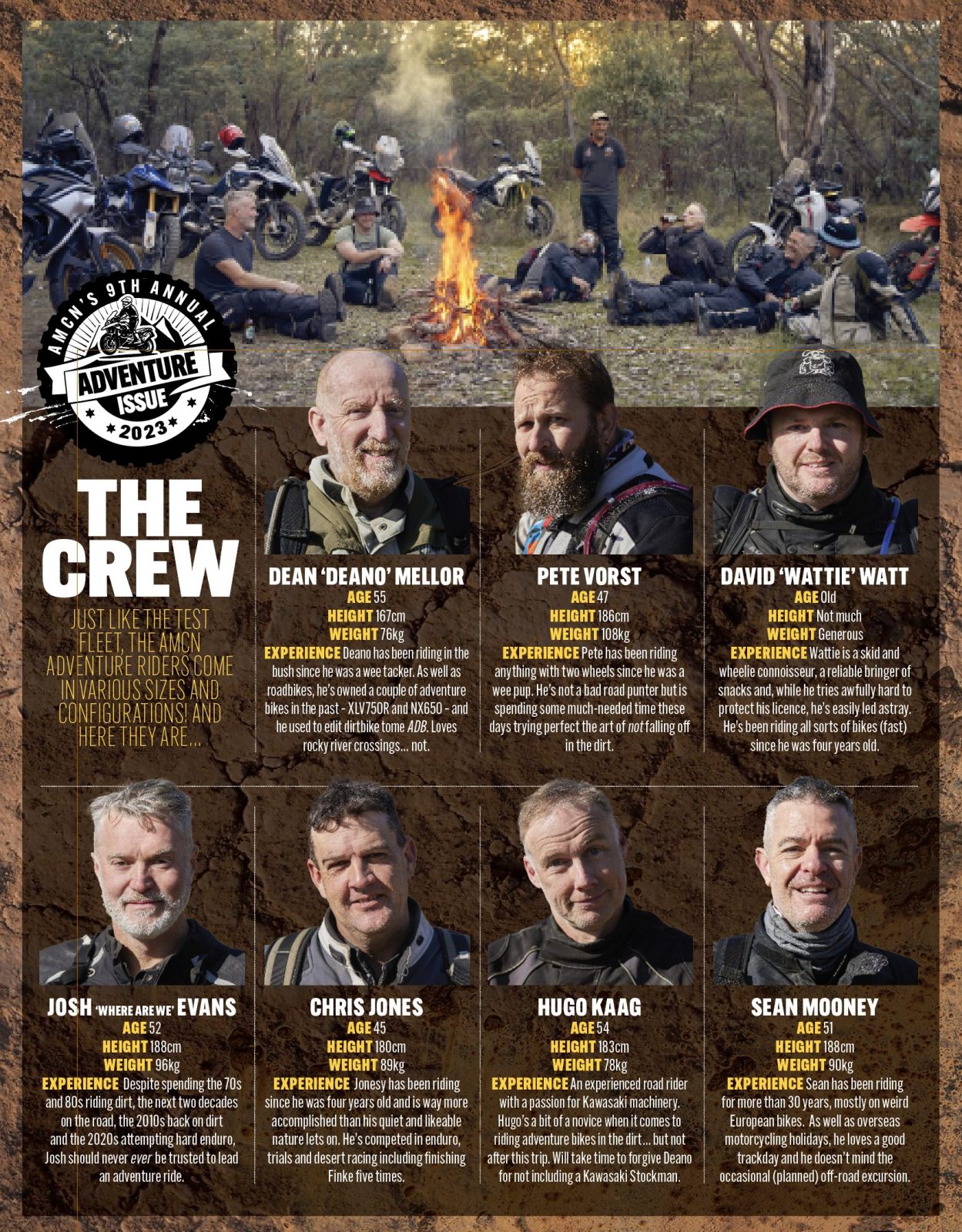
EATS DIRT – APRILIA TUAREG 660
It might be the smallest bike of the group, but the Aprilia Tuareg 660 is a big-hitter once the blacktop turns to dirt
I’ll get this out of the way from the start: I had more fun on the dirt on the Aprilia Tuareg 660 than on any other bike on test. On one run up a twisty dirt road I really gelled with this midsize Italian and had the time of my life, sliding out of corners and jumping over erosion mounds while chasing the Ducati DesertX ahead of me. The Tuareg 660 might not have the power of the bigger adventure bikes on test, but it’s so light and flickable that you can’t help but have a good time on it.
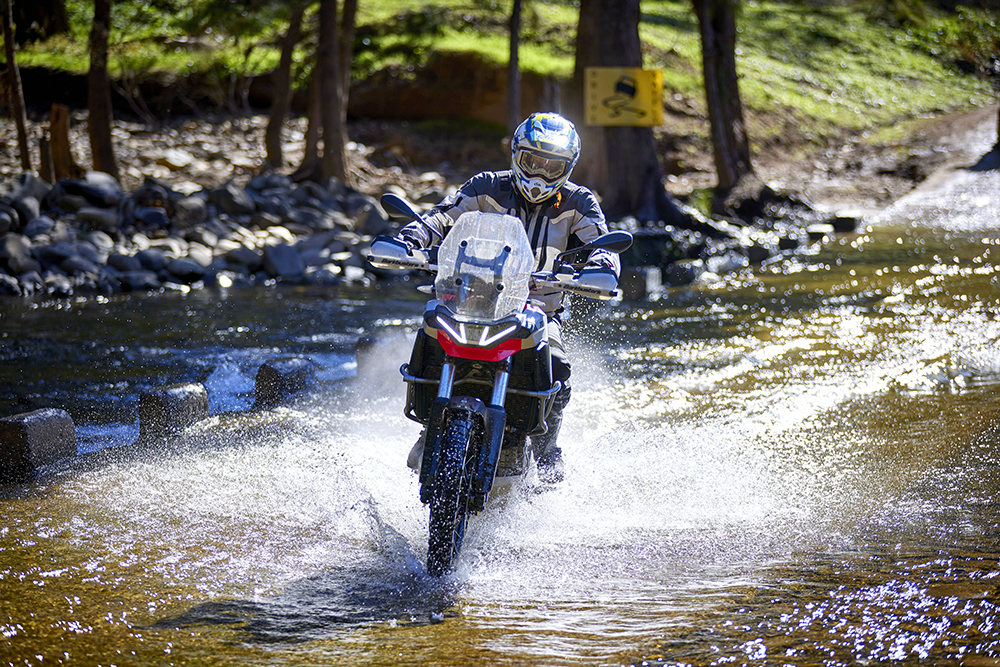
I’d been hanging out to sample it since reading Mav’s glowing launch report and I had no hesitation in putting my hand up to grab the Tuareg for the few days prior to setting off on our 2023 adventure ride. And there were several things I liked about it straight off the bat: it’s light (187kg dry), it’s accessible (860mm seat height), it runs a sensible off-road 21-inch/18-inch wheel sizes, and it looks bloody fantastic.

On the downside, strapping a bag to the back isn’t so easy with no rack nor tie-down points, but that was a small price to pay once I hit the dirt. Before that, however, there was plenty of sealed road riding to be done. At the heart of the Tuareg is Aprilia’s brilliant 659cc parallel-twin. It offers decent punch from low revs and a strong midrange, and thanks to its 270° crank it’s smooth and sounds fantastic.

With peaks of 61kW (83hp) and 70Nm, it’s down on power compared to the larger-capacity machines on test, but low overall gearing means it still offers engaging on-road performance – even if it does feel a tad busy at highway speeds. But as mentioned, where the Tuareg really shines is when the tarmac runs out. The stand-up riding position is spot-on, the footpegs are wide and grippy, the fully adjustable KYB suspension is compliant, and the Pirelli Scorpion Rally STR rubber offers decent loose-surface grip.

The Tuareg has a comprehensive electronics package with four ride modes – Urban, Explore, Individual and Off-Road – that can be selected on the fly. The latter two can be customised and Off-Road mode disengages the rear ABS so you can slide into corners. You can also disable the front ABS and the traction control.
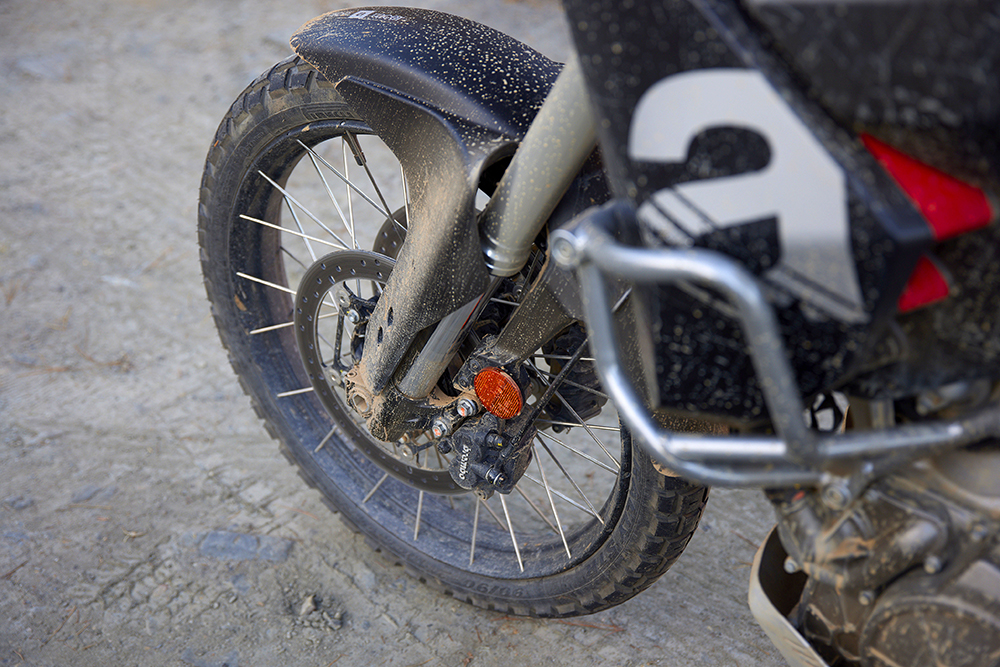
Ride modes are clearly displayed on a bright TFT screen, along with all the other info you’ll ever need. A generous 240mm of wheel travel at each end, 240mm of ground clearance and that 21/18-inch wheel combo ensures the Tuareg is capable in rough off-road conditions too.
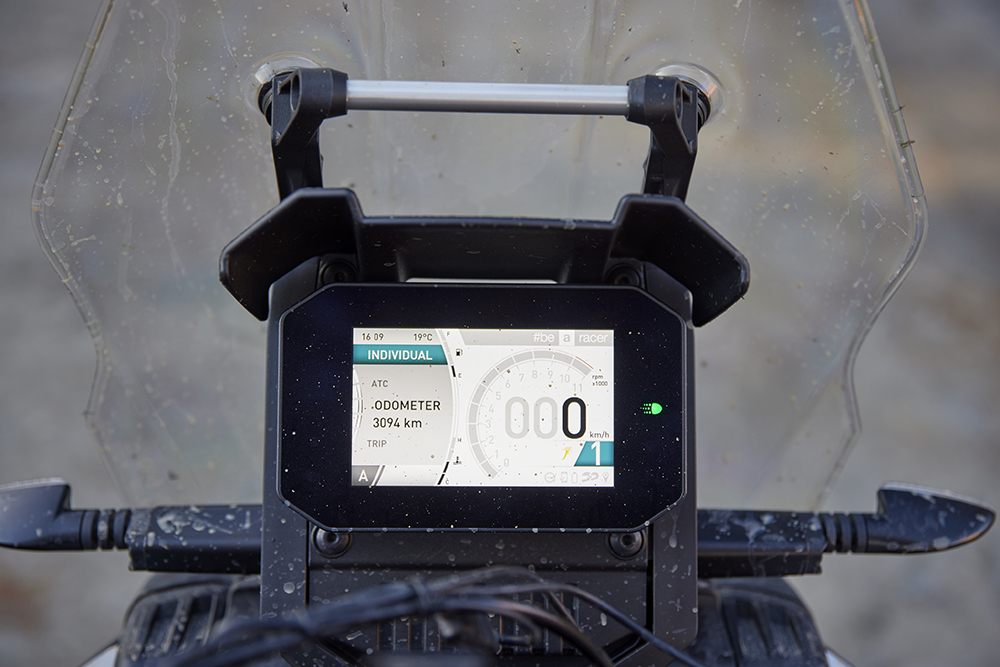
The 18-litre fuel tank provides a decent touring range and the windscreen is effective, but if you have long road miles to cover you probably won’t find that narrow seat so comfy after a few hours in the saddle. For adventure riders who want to tackle the hard stuff off-road, the Tuareg 660 is up there with the likes of the Yamaha Ténéré 700 and KTM 890 Adventure R.
Dean Mellor
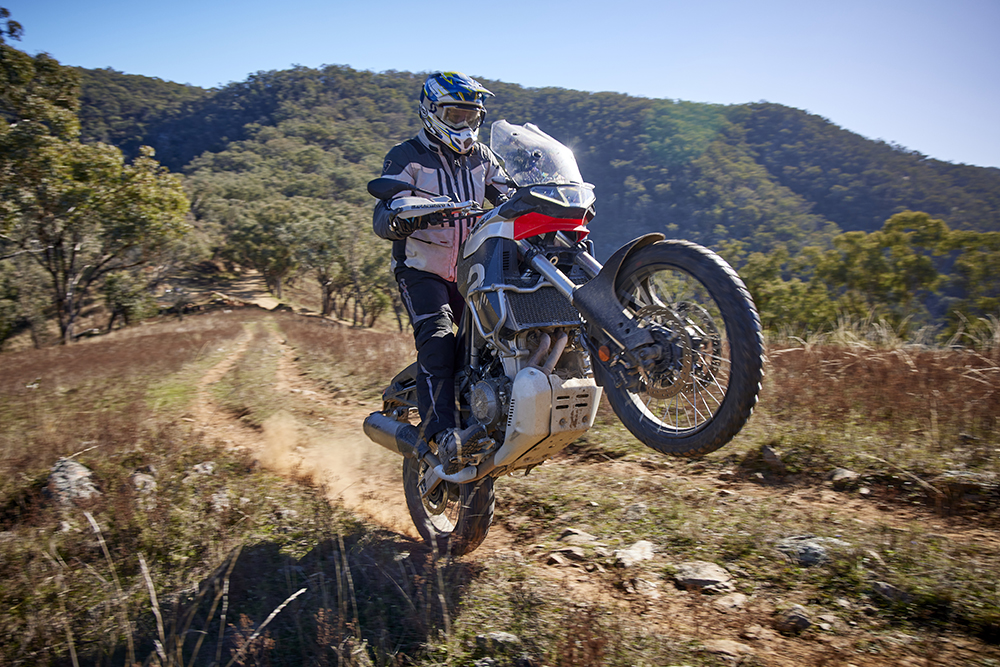
SECOND OPINION
The Tuareg is a dirtbike through and through and it’s never more comfortable than when you’re up on the ’pegs and attacking a section of dirt. On the flipside, I felt awkward seated on the Tuareg; a high ’bar and a seating position that sits you in rather than on the Aprilia and had my shoulders smarting after a short while.
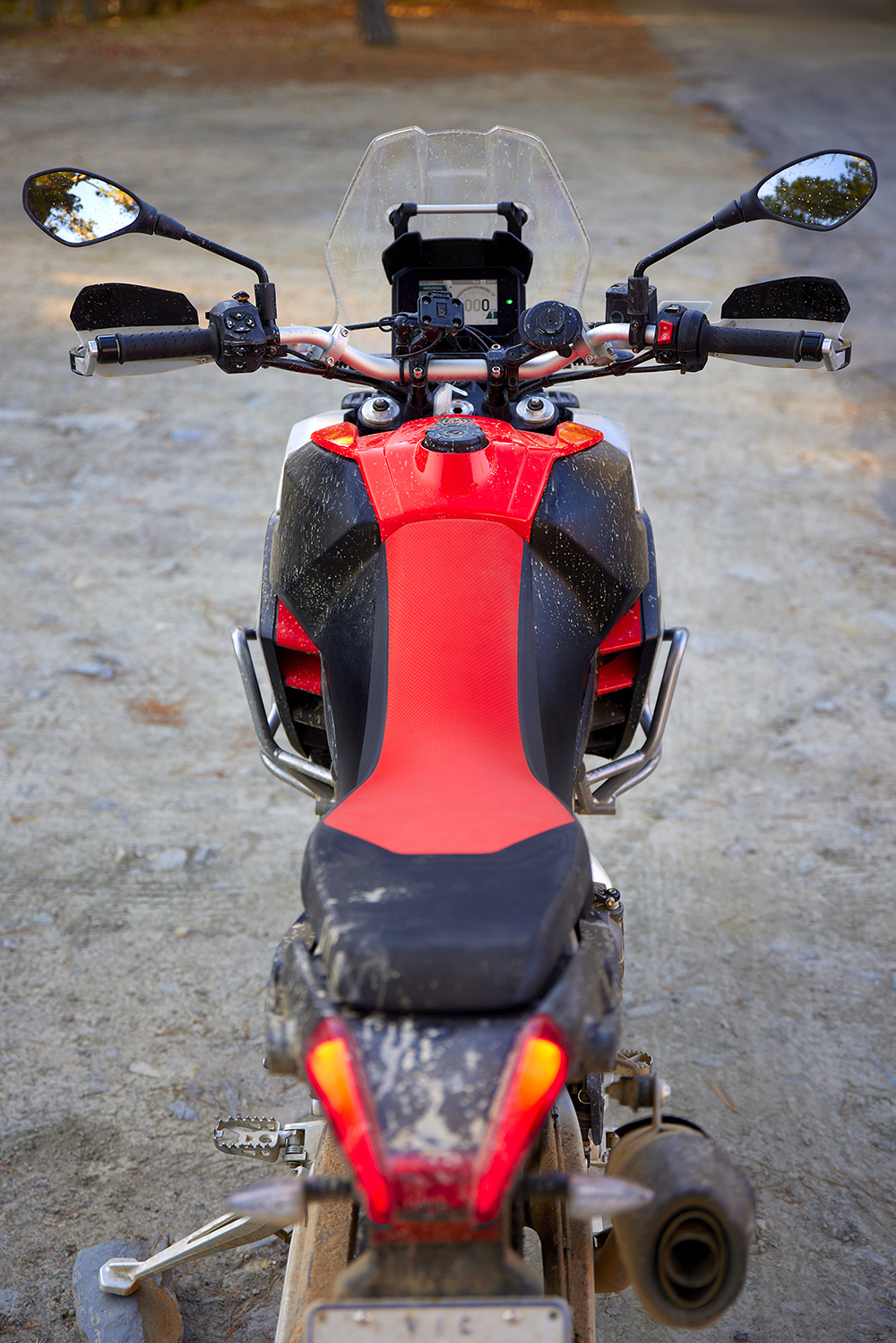
The Tuareg lacks the cubes to be considered a true two-up, luggage-hauling adventure touring option, but if you’re a solo rider that’s fond of getting dirt under your adventure wheels then I reckon the Tuareg is about as good as it gets.
Pete Vorst

WORLD CUP – BMW R 1250 GS TROPHY
If you want a big-bore adventure bike for seriously long-distance touring, it’s hard to go past the venerable BMW R 1250 GS
There’s no doubt the BMW R 1250 GS Trophy is an imposing machine, especially when you need to ride it up a tricky rock shelf to get it where the photographer wants it, but despite its bulk and its 249kg (wet) weight it is surprisingly agile once on the move thanks in part to its low centre of gravity. The low setting on the standard seat helps, too.
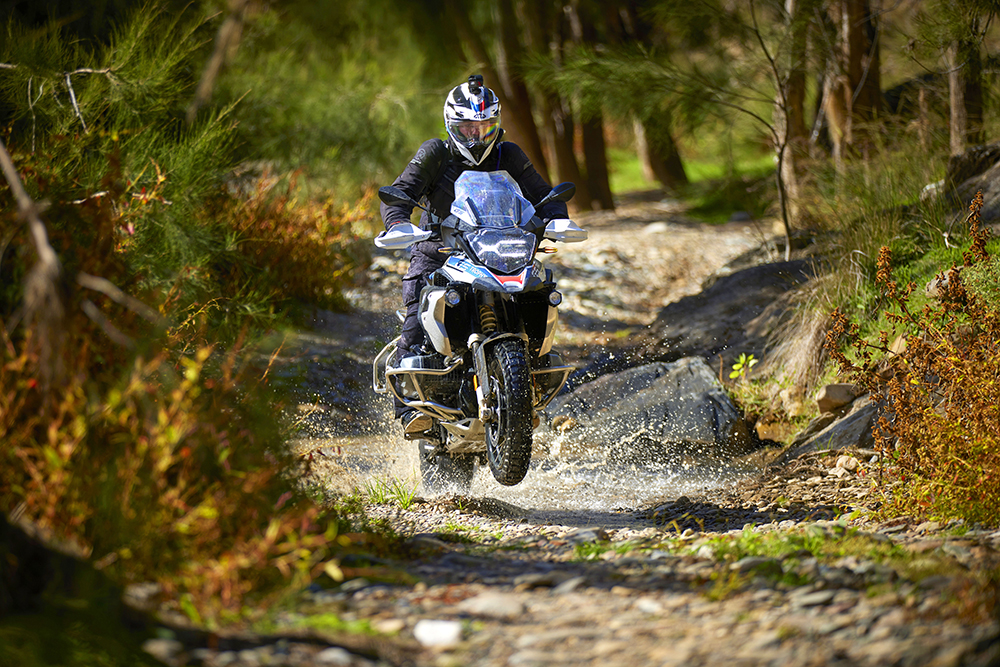
The GS Adventure is powered by BMW’s famous 1254cc boxer twin that pumps out an impressive 100kW (136hp) of power and 143Nm of torque, and ShiftCam tech ensures there’s plenty of throttle response across the rev range, from the grunty bottom-end all the way to the potent top-end. There’s also precise fueling throughout.

This is a bike built for long-distance touring and it’s not only supremely comfortable but also offers fabulous performance and handling.
The Telelever front-end inspires confidence on the road that not many bikes can match; flick the ride mode over to Dynamic and the GS will keep most sports-tourers honest on a twisty road, then flick back to Road and you’ll have a comfortable ride over crook road surfaces.

Ride modes include Eco, Rain, Road, Dynamic, Dynamic Pro, Enduro and Enduro Pro, and modes can be tailored through sub-menus. In addition to adjusting the suspension settings, the ride modes adjust engine mapping, throttle response, TC intervention, ABS actuation and more. You’d need a few weeks to fully explore all the settings but essentially Enduro Pro is an off-road mode that lets you lock the rear wheel, spin the rear wheel and, of course, pull wheelies.

In addition to the standard GS kit, the Trophy (as tested) comes with a Comfort Package (keyless start, heated grips and TPMS), Dynamic Package (Riding modes pro, Gear shift assist pro, Dynamic electronic suspension adjustment and Dynamic engine brake control), Lights Package (DRL, Headlight Pro and adaptive headlight) and Touring Package (hand guards, pannier mounts, cruise control and navigation cradle). In addition, it gets distinct styling features and an accessible but adjustable seat. All that kit doesn’t come cheap and you’re looking at almost $35k ride away for the R 1250 GS Trophy.
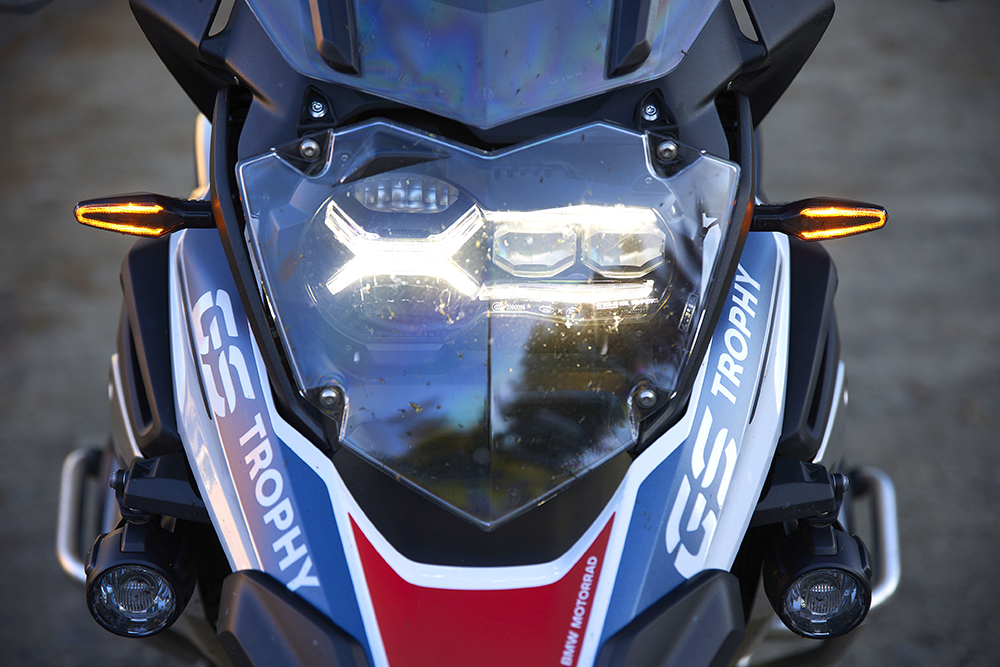
Of course, BMW will be more than happy to take even more of your cash if you want to hand it over and there is an extensive options list for the GS. From a practicality perspective, the R 1250 GS is about as good as it gets, with an effective and adjustable screen, handguards, comfortable seating, great ergonomics, bash plate and plenty of places to attach luggage. And there are probably more aftermarket accessories to suit the GS than just about any other bike on the market.
If you’re after a proven adventure bike that can eat big miles, as quickly or as slowly as you want, and as comfortable as it gets, you’d be hard-pressed to find anything better than the R 1250 GS, and the Trophy edition adds a heap of extra kit.
Dean Mellor
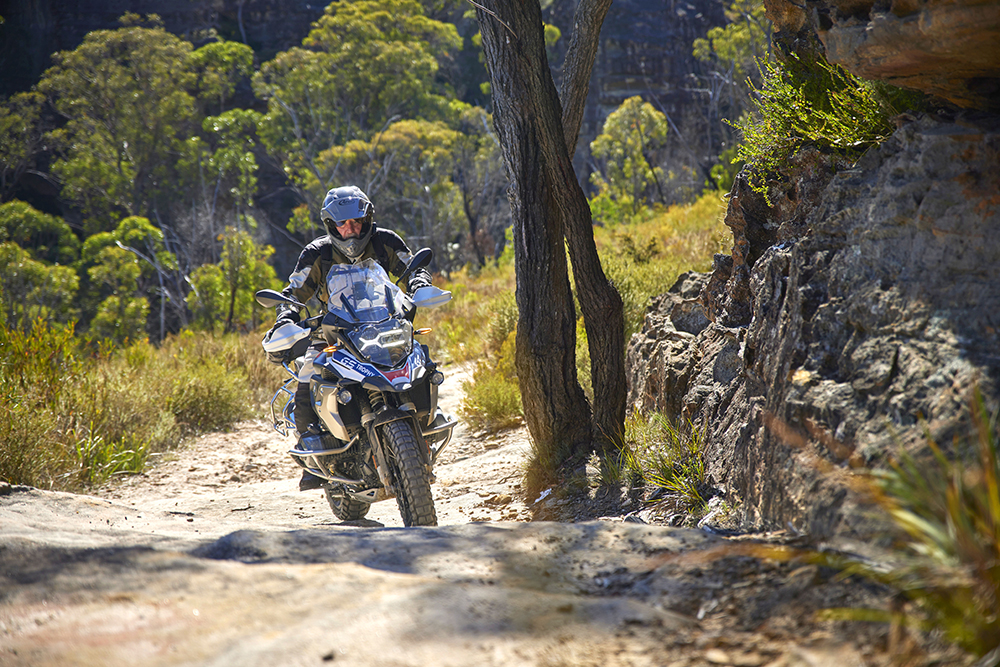
SECOND OPINION
There aren’t many superlatives that haven’t been used to describe the BMW GS, and the R 1250 GS Trophy is no exception. It feels like the big bertha of the bunch, but BMW has refined the design over so many years that it really does perform way better than it has any right to.

Once you get your head around the feeling of the Telelever front suspension and the engine configuration, the GS is a breeze to punt along the trails. It’s so well balanced, slow-speed manoeuvres will make you look like a god. The 1254cc boxer has oodles of grunt, electronics are second to none and build quality is top of the class.
David Watt

Fully loaded – CFMoto 800MT Explore
Here’s a bike loaded with high-tech kit, comfort and convenience features, but without the fully loaded price tag.
When CFMoto launched the 800MT last year, I was blown away by the spec that was on offer for the asking price. Even the top-of-the-line 800MT Touring was priced at an affordable $14,990 ride away, yet it was packed with kit including ride-by-wire throttle enabling two ride modes, cornering ABS, slipper clutch, quickshifter, steering damper, centrestand, cruise control, seven-inch TFT with Bluetooth connection, fog lights, adjustable screen, 12V/USB outlets, heated grips, heated seat… and more! But there was one glaring omission that affected its ability on dirt: traction control.
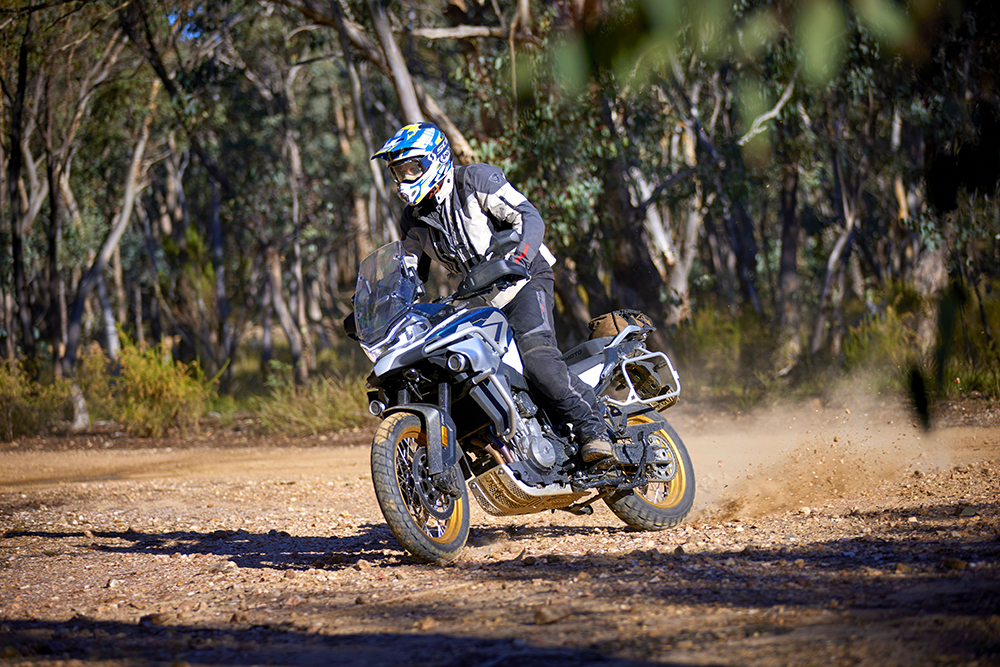
CFMoto has seen fit to rectify the lack of TC on this latest Explore model. And not only does it now come with traction control, it also scores other upgrades including rear radar enabling blind-spot detection, lane-change assist and rear-collision warning, an eight-inch TFT screen with Apple CarPlay/Andriod Auto, six selectable ride modes, switchable ABS front and rear, and Michelin Anakee rubber. The price is now up to $16,490 ride away – still a helluva lot of bike for the money.

One of the best things about the 800MT is its potent KTM-designed, CFMoto-built parallel-twin engine that makes a claimed 67kW (91hp) at 9250rpm and 75Nm at 8000rpm. It offers loads of punch from down low and a strong midrange, and the improved fueling makes it easier (and more pleasant) to ride both on the road and off it.
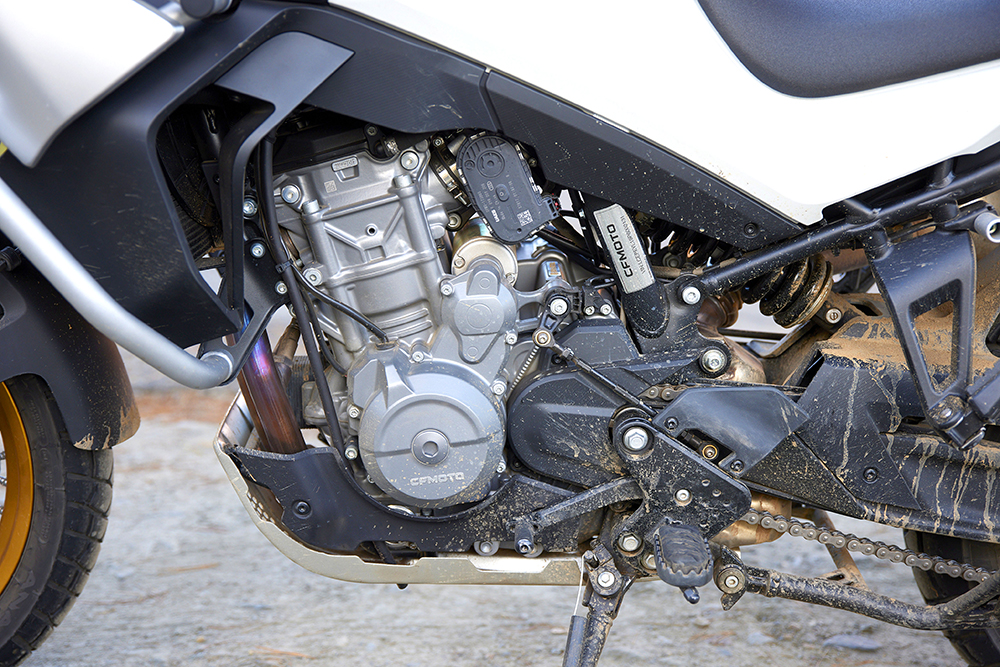
Compared to some of the more off-road oriented bikes on test, you sit more in the 800MT than on top of it, which is great for comfortable long-distance cruising but feels slightly odd when standing on the ’pegs for off-road riding. Seat height is an accessible 825mm.
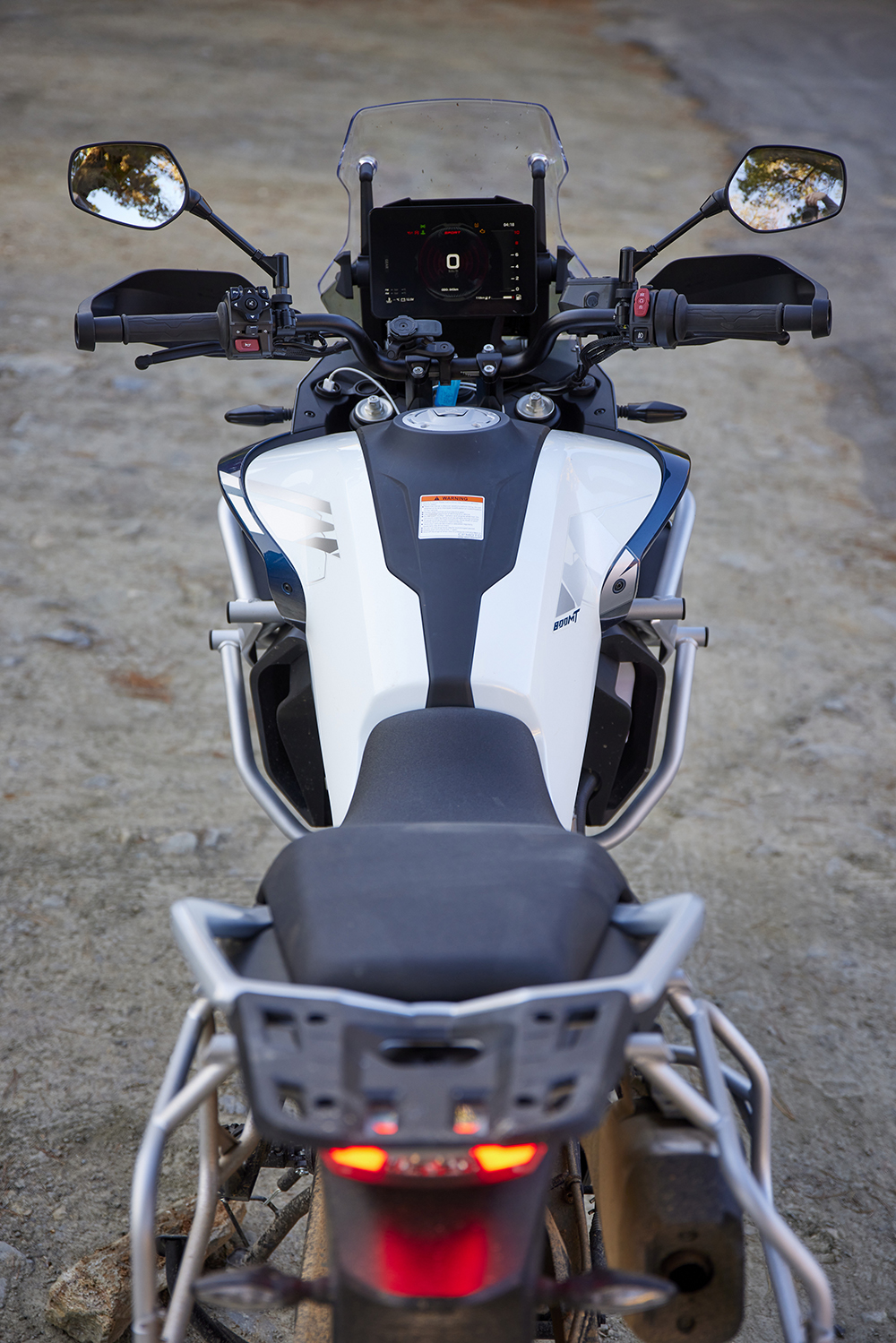
The new ride modes include Sport, Off-road, Off-road+, All-terrain, All-terrain+ and Rain. The Off-road+ mode has the lowest level of TC intervention and ABS is deactivated on the rear, while the All-terrain+ mode disables TC altogether and deactivates both front and rear ABS. Accessing and changing the ride modes is through the TFT touchscreen, which it can be a bit fiddly. And once you switch the bike off it defaults to standard settings on start-up, so you have to go through the process again…
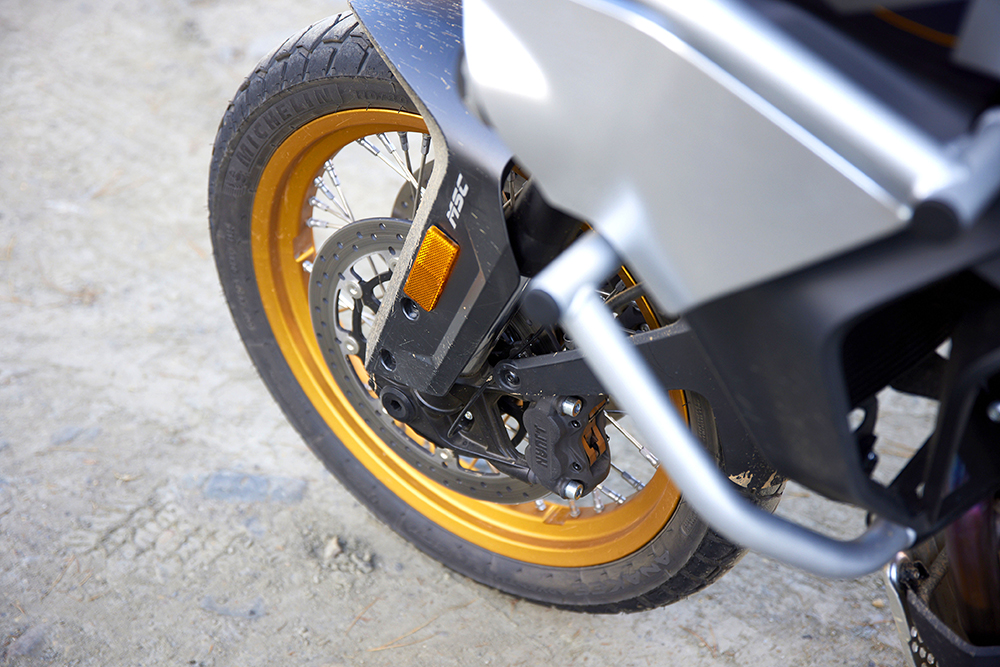
Hardware on the 800MT includes a 19-inch/17-inch wheel combination, fully adjustable 43mm USD fork and preload and rebound adjustable monoshock with 160mm travel up front and 150mm at the rear, and a J.Juan brake package. The suspension feels more suited to sealed and well-groomed gravel roads than rough terrain, but with a decent bash plate fitted as standard and 190mm of ground clearance it’s still reasonably capable.

Big pillion grab handles and pannier frames fitted to our testbike make it easy to attach luggage, while other touring niceties include the adjustable screen, standard handguards and tyre pressure sensors.
Dean Mellor
SECOND OPINION
The CFMoto is aimed at the road end of the spectrum despite this new Explore variant having a bunch of rider aids aimed at improving the rider experience off-road. However, the rear radar system and Michelin Anakee tyres are clearly there to improve the on-road experience. The main issues I had with this bike on dirt were the tyres and the shape of the tank that makes it hard to grip while standing on the ’pegs. On the tarmac it excelled and proved to be a very capable tourer. Heated grips and seat, massive display, strong engine and plenty of racking make this one of the most comfortable rides between dirt stretches.
Hugo Kaag
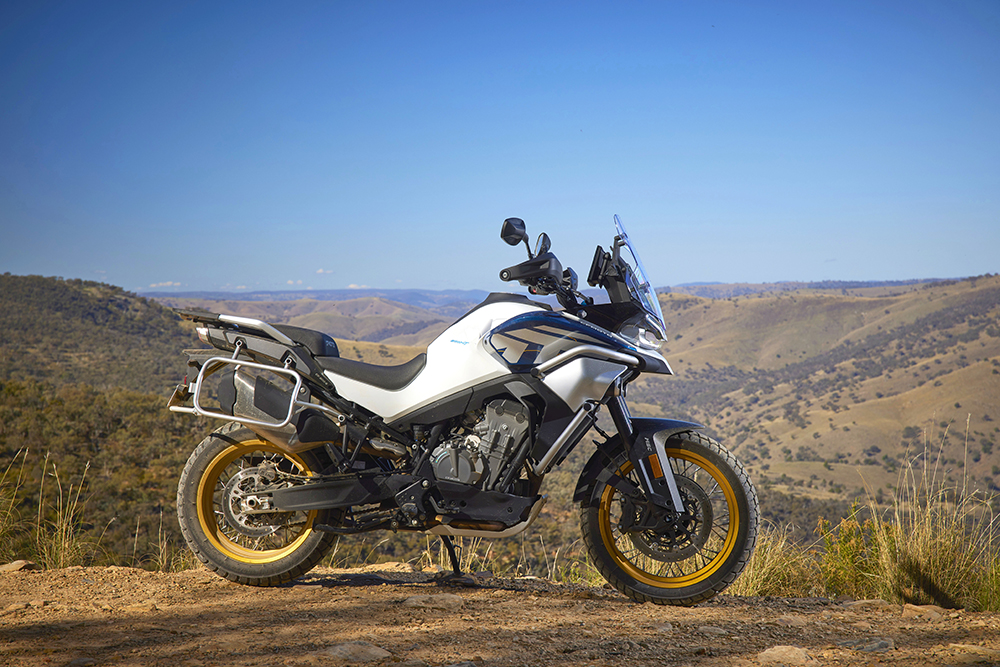
X factor – Ducati DesertX
The DesertX isn’t your typical latte-locating Ducati: this is a serious mile muncher both on the road and off it
First impressions are important, and between its polarising looks, the impressive specs and confidence-inspiring ride the DesertX makes one helluva first impression.
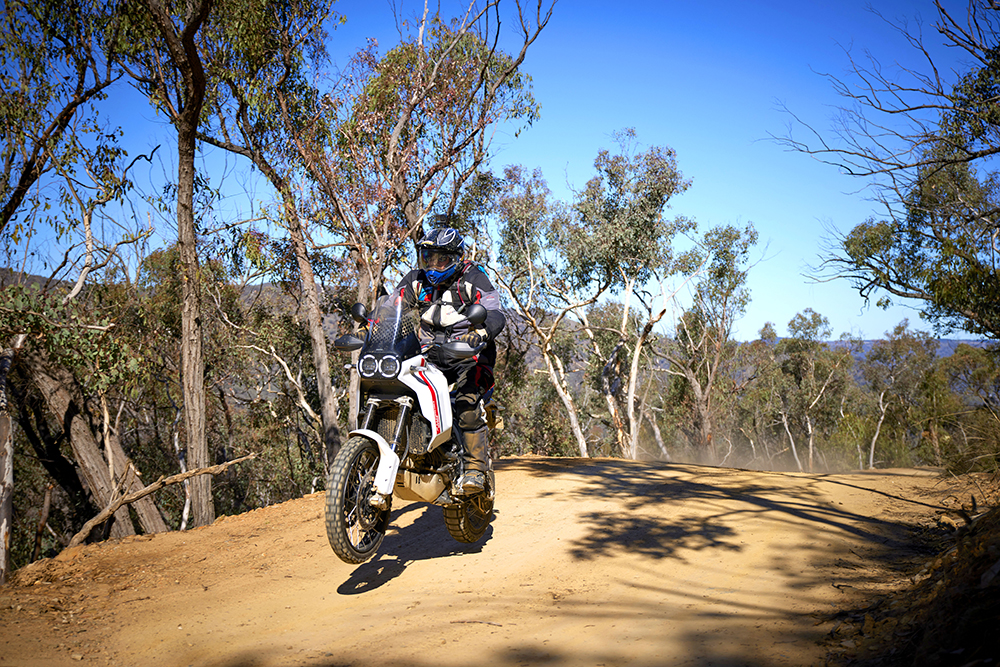
The DesertX impressed me with its road manners on the MOTY test at the end of last year – it’s comfortable, powerful and capable of mixing it with the best adventure tourers in the business – but this was my first significant off-road ride on the model. I’m no demon off-road rider, so having a bike that instils confidence when you leave the blacktop is important and the DesertX is just such a beast – like the Aprilia and KTM.
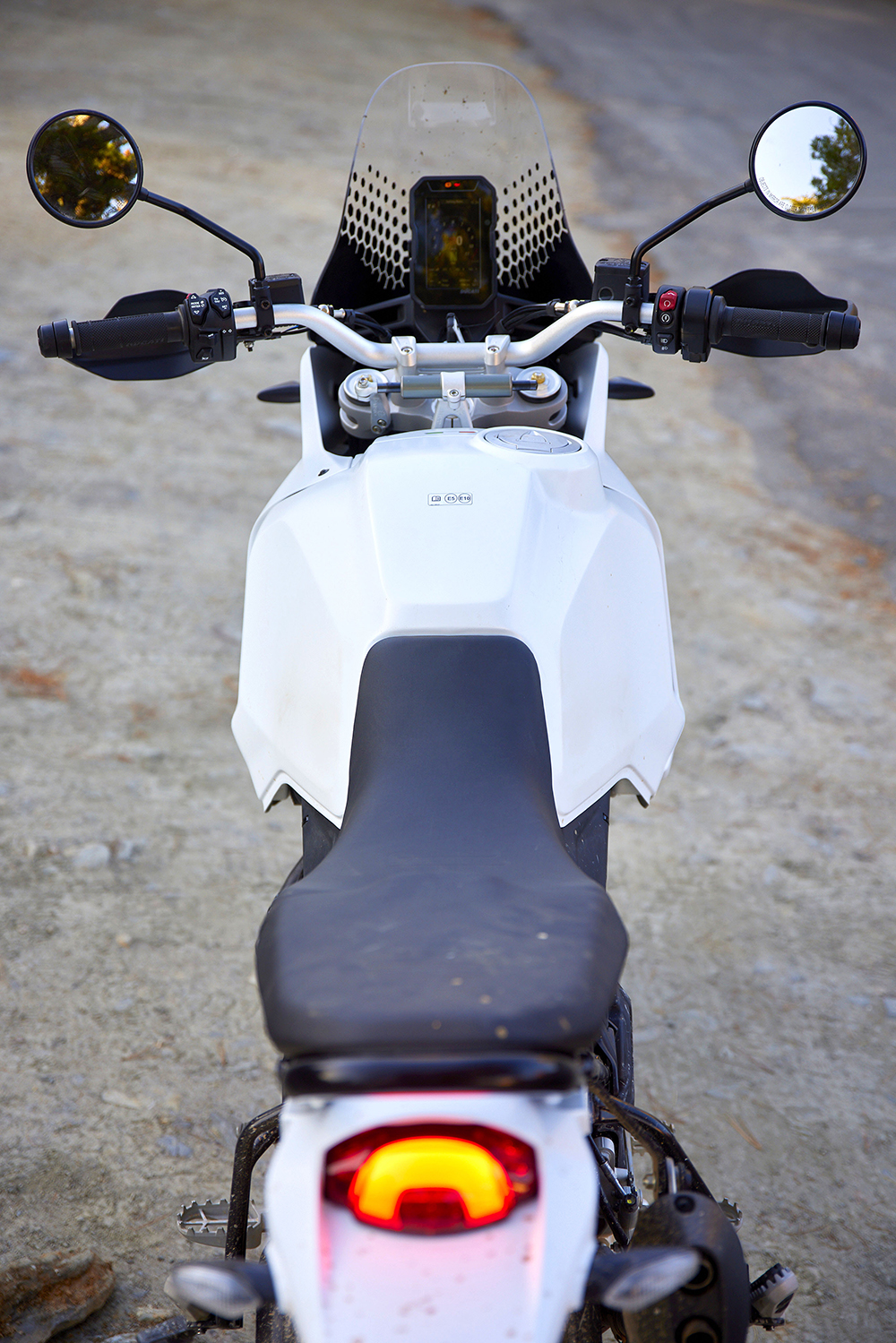
The Ducati is powered by a 937cc V-twin with a claimed 81kW (110hp) of power and 92Nm of torque. Yes, the DesertX might lose out to some of the 150-plus horsepower mega adventure machines, but you’re unlikely to be longing for more power or torque either on- or off-road. The Testastretta engine is a peach, with plenty of low-down grunt and a strong top-end rush, the latter a bonus on the tarmac when speeds are higher. But the low-down grunt is just the ticket off-road where you can lean on the torque for slow-speed technical riding or use it to run a taller gear when grunting out of corners.

The Ducati’s suspension is on the soft side, which makes for a smooth and supple ride, but the X can run out of travel quickly if you’re aggressive off-road – with my weight, landing even modest jumps can be a bone-rattling experience.

The 223kg DesertX is pulled up by a Brembo braking package that consists of twin 320mm discs on the front pawed at by monobloc calipers and a twin-piston caliper gripping a 265mm disc on the bum. The brakes have formidable power but enough feel that even if you switch the ABS off there’s plenty of confidence to get the braking right.

Standard seat height is 875mm which suited my 186cm frame just fine, however there are seat options out there for riders of a squatter stature. The DesertX has no shortage of electronic aids in standard form with various ride modes, power modes, cornering ABS, wheelie control, a two-way quickshifter, traction control and more, all of which you can disable or adjust.

The portrait-orientation TFT and its associated buttons can be a bit convoluted, but it doesn’t take long to get used to how it all works. The vulnerable steel tank scares my wallet and crash bars would be high on my shopping list, and I still think having to pull half the bike apart to get to the airfilter is a really bad idea.

At $25,800 ride away it’s right on the money for an adventure bike of this specification. But with its snazzy looks, solid list of standard features, all-round capability and build quality I actually reckon it’s great value and an adventure bike I’d be proud to have in my shed.
Pete Vorst
SECOND OPINION –
A Ducati that can really mix it with the best off-road? Not just on a dirty B-road, but also mud, rocks and water? Yep, the DesertX is all that and more. More, because it is also a fantastic road bike.
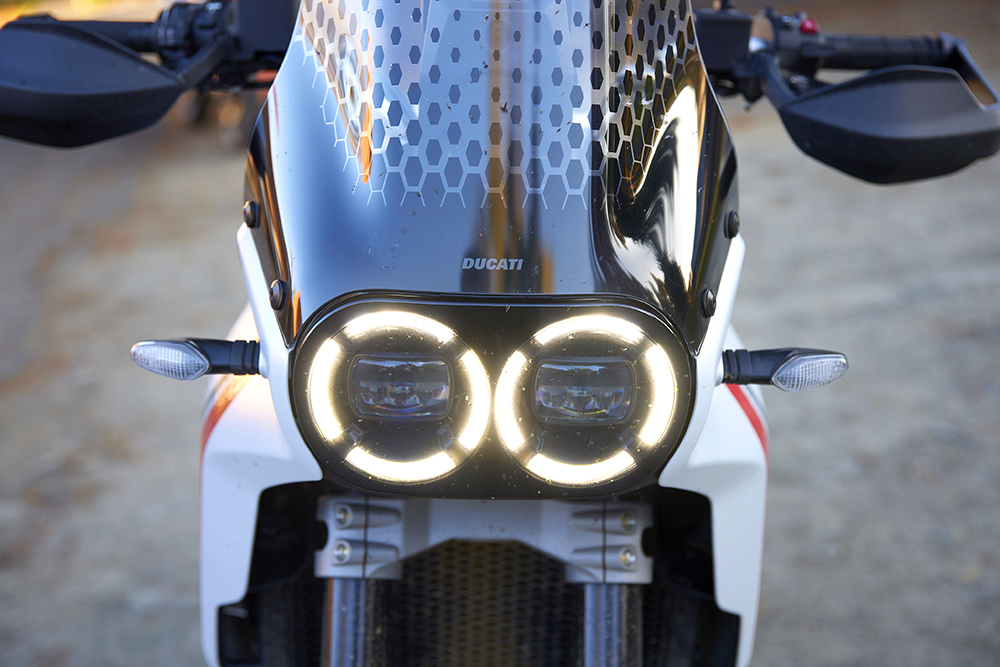
The first Ducati built from the ground up to be a proper off-roader (note the 21/18-inch wheels, long-travel suspension and specific frame), the DesertX still isn’t perfect; the air filter faux pas is a real oversight. But the combination of the lovely V-twin with Ducati’s suite of electronic wizardry is really enticing. I love the looks, feel and performance of this surprising machine.
Sean Mooney

Journeyman – KTM 890 Adventure R
Outstanding off-road chops and cranking out kays in comfort: is there anything the 890 Adventure R can’t do?
The KTM and Aprilia are the most off-road capable bikes of the group and, despite the 20-odd kilograms extra the KTM is dragging compared to the Aprilia, it offers more comfort and confidence for a larger unit like myself both on the road and off it.

The KTM’s 889cc parallel-twin is blindingly fast with 77kW (103hp) of power and 100Nm of torque on call at a moment’s notice and, if you’re one of those who may think the 890 is lacking cubes to be a big-mile bike, you’re simply incorrect – I don’t remember punters concerned about a lack of power when the 950 Adventure was first released and it put out less power and torque than this.
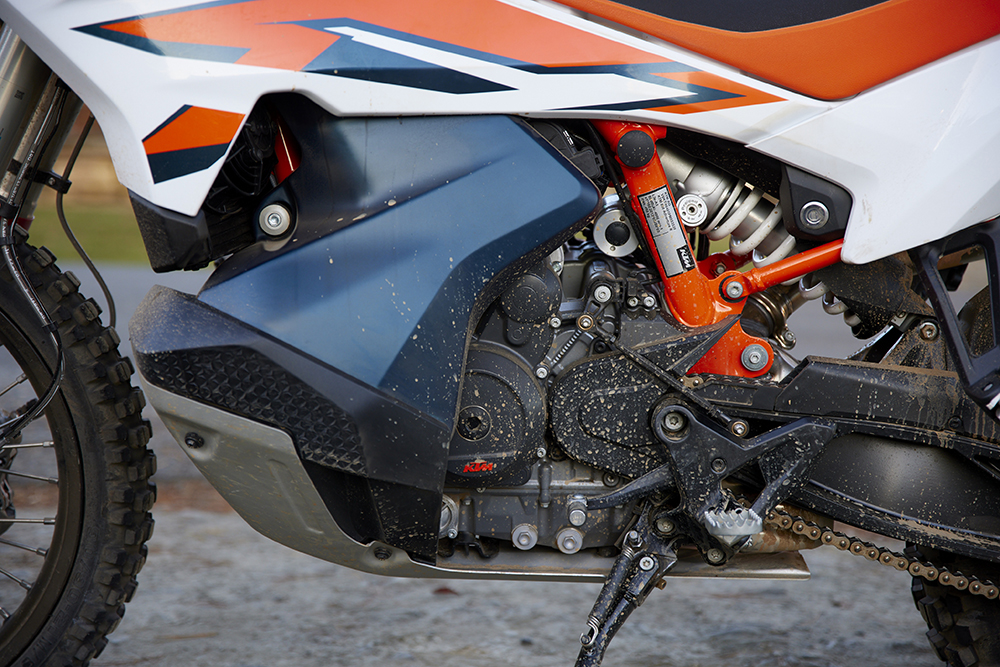
The KTM feels like a dirtbike the minute you climb on board, and once you’re rolling the fully adjustable WP suspension comes into its own. There’s a healthy 240mm suspension travel at both ends, 263mm of ground clearance and I instantly felt at home and in control when up on the ’pegs. With my 108kg on board, the Adventure R was the only machine that didn’t bottom out when landing from big jumps with the suspension firming up beautifully in the latter part of the stroke, while the initial portion of the stroke is supple enough to shrug off all but the nastiest lips and ledges.

The KTM carries its fuel payload low thanks to the design of the engine-flanking tank which really minimises the top-heavy feel that afflicts so many adventure machines. Far from a one-trick pony, because while it’s brilliant off road – the best of the bunch in my opinion – it feels right at home on the tarmac as well.

There’s oodles of power and torque, the seating position and ergonomics are on point – although the seat isn’t as comfortable as some and feels harder and thinner – there’s standard cruise control and optional heated grips.
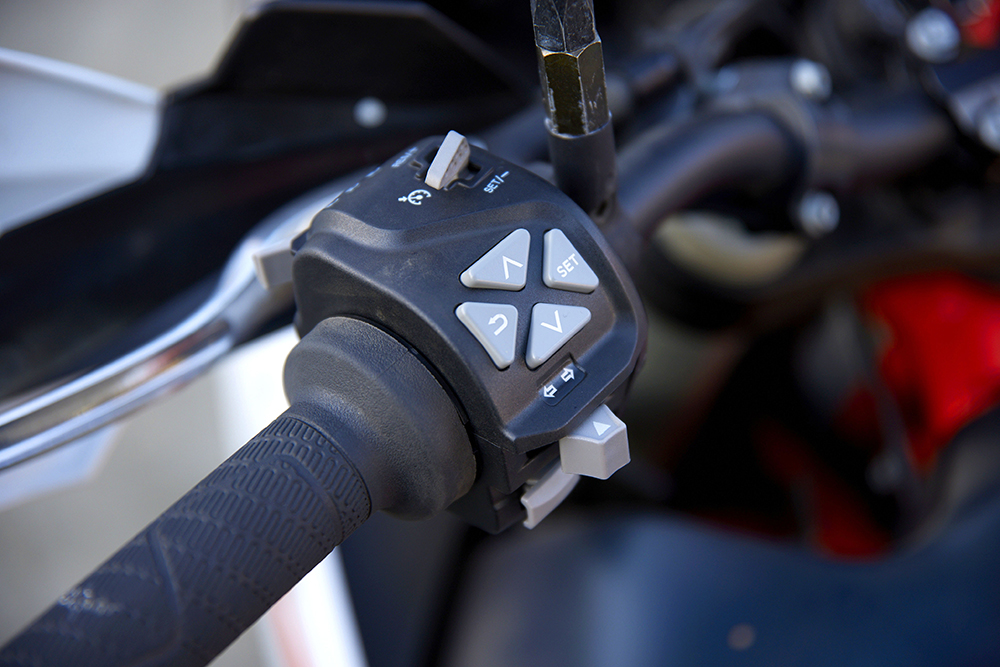
KTM claims a 200kg dry weight so once you’ve filled the Kato’s 20L tank and whacked other essential fluids in, you’re looking at something around the 225kg mark, right on par with the likes of Ducati and Triumph. But it feels lighter and nimbler than the numbers suggest.
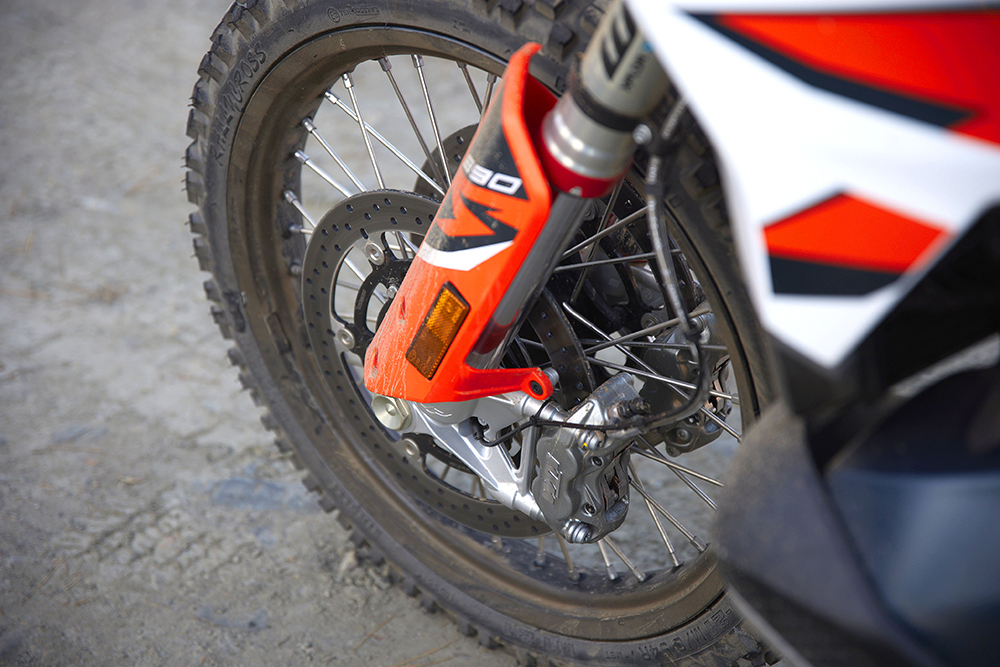
There’s a full suite of electronics, from dirt-focused ride modes to cornering ABS assisting the brilliant J.Juan braking package. A two-way quickshifter cuts through the slipper-clutch infused six-speed ’box, which never throws up neutrals or misbehaves but does lack the silky-smooth action of say the V-Strom’s quickshifter.

I find it hard to fault the KTM; perhaps an adjustable screen would be nice, the seat could be a little comfier but both come down to personal preference. I feel somehow violated that the KTM is fitted with a lot more electronic kit than you actually get when you buy the bike, and that having KTM switch it on is a matter paying the dollars, but that’s not a ploy unique to KTM these days.
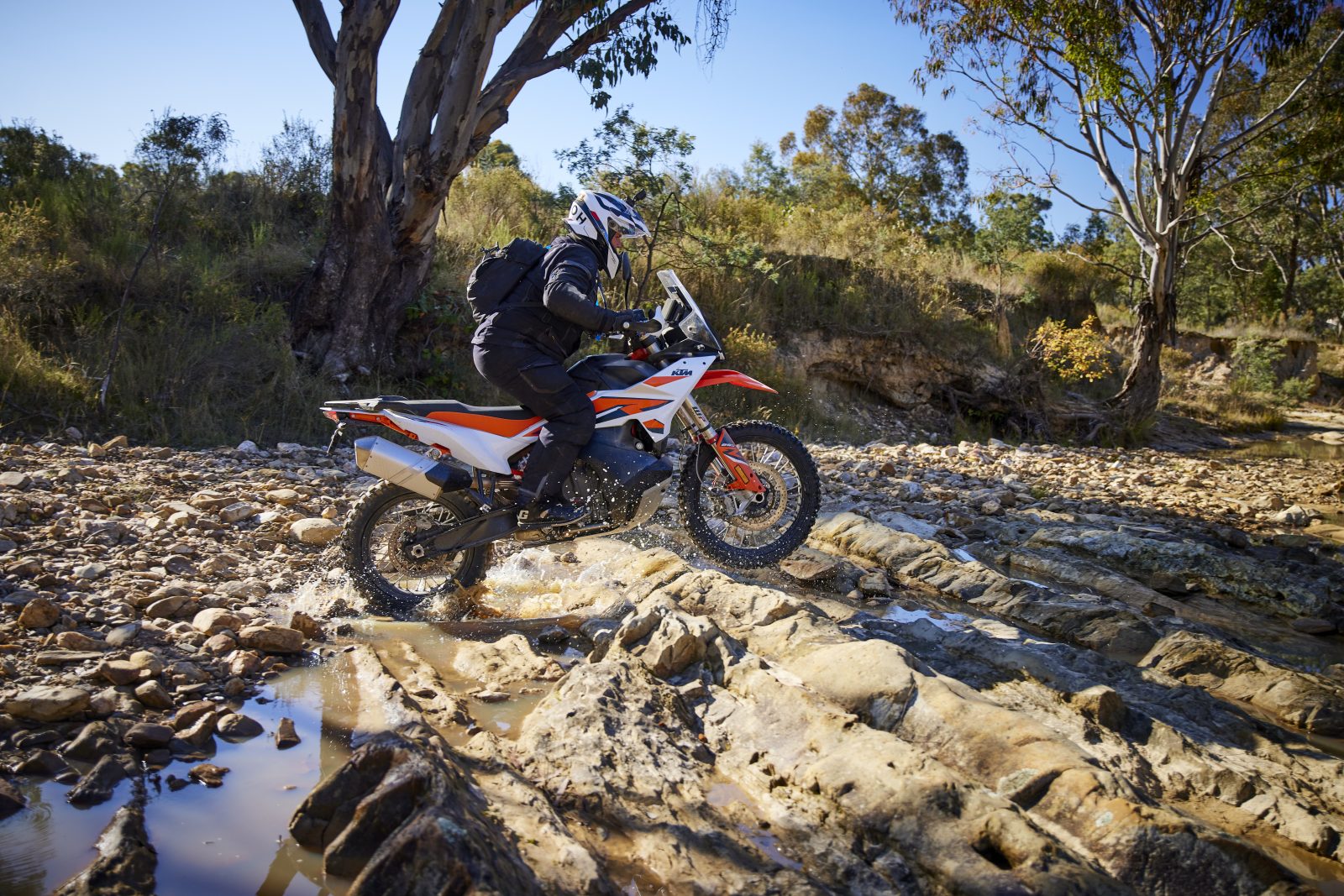
It may not be the most comfortable for long road miles but the 890 Adventure is the perfect blend of road and dirt prowess.
Pete Vorst
SECOND OPINION
The KTM was a standout in this group. When the tracks get rough this bike reigns supreme and by a fair margin thanks to its suspension. The engine has a lot of mechanical noise but provides all the power you’ll ever need and the electronics package makes it all very easy to customise.

Sitting or standing the KTM is comfortable, the brakes are exceptional and I could easily punch out big days in relative comfort. The bike inspires confidence for those of you that will push hard on the dirt. For me, as an off-road rider, the KTM is the bike I’d take home.
Chris Jones

The big rig – Suzuki V-Strom 1050DE
Suzuki’s ramped up the off-road performance without losing the touring ability that’s made it so popular
The V-Strom 1050DE has more right than any V-Strom before it to be considered a serious contender in the adventure-bike scene. Suzuki’s addition of a 21-inch front rim, long-travel suspension and a software suite with dedicated off-road settings has lifted the off-road potential without degrading the V-Strom’s reputation for punching out mega miles in comfort with legendary levels of performance and reliability.

The ’Strom’s stonking 1037cc V-twin has a claimed 79kW (106hp) of power on tap and 100Nm of torque so there’s more than enough squirt for highway use either solo, two-up or loaded up. The tried and tested V-twin is as comfortable off-road as it is on, and the predictable way the ’Strom delivers its torque is perfect for fat power slides and tractable control.
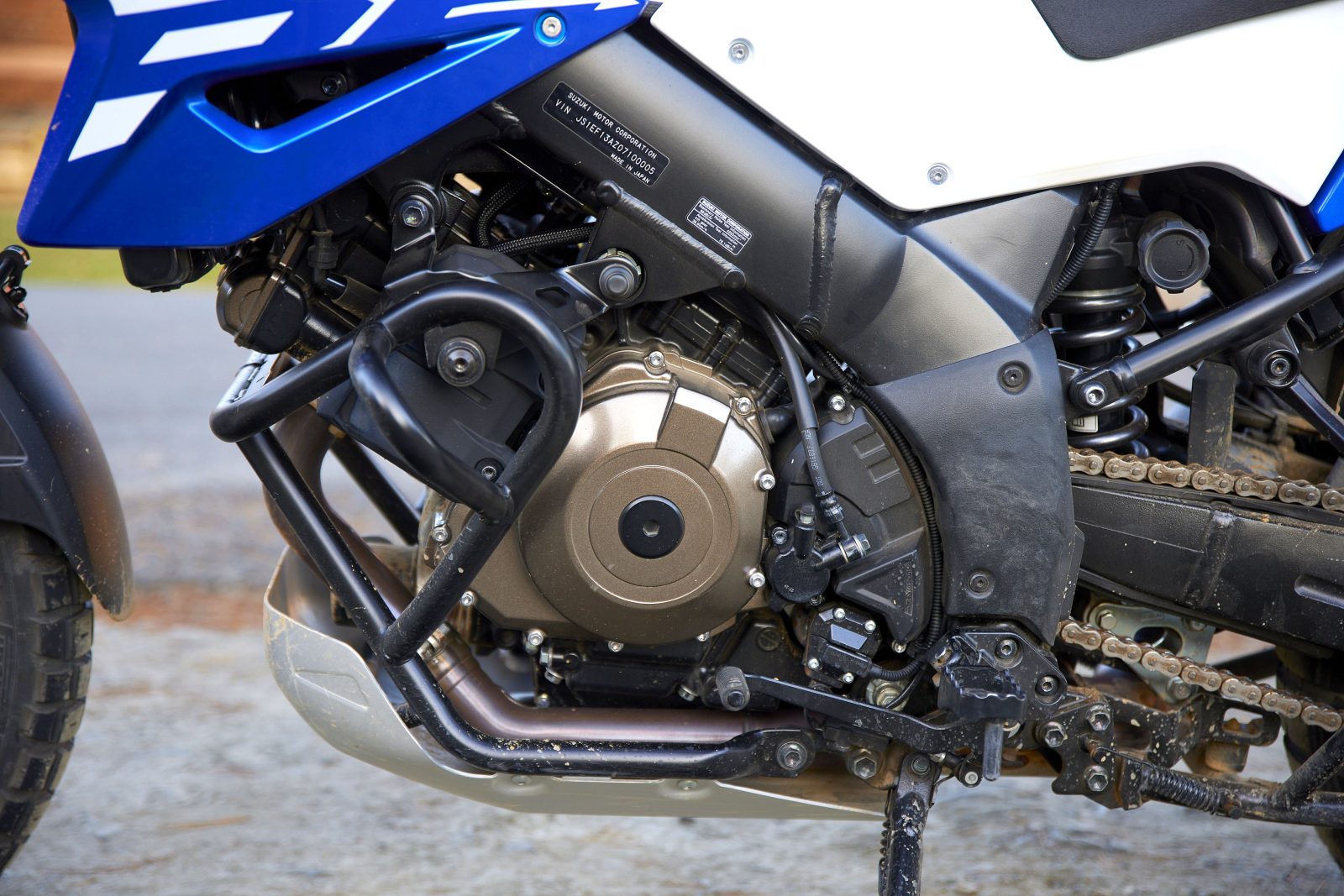
The new Gravel mode lets you slide the rear with the comfort of knowing the bike’s brain has your back, and being able to switch traction control and ABS off altogether is pretty important if you’re going to explore the uglier side of off-road adventure life.
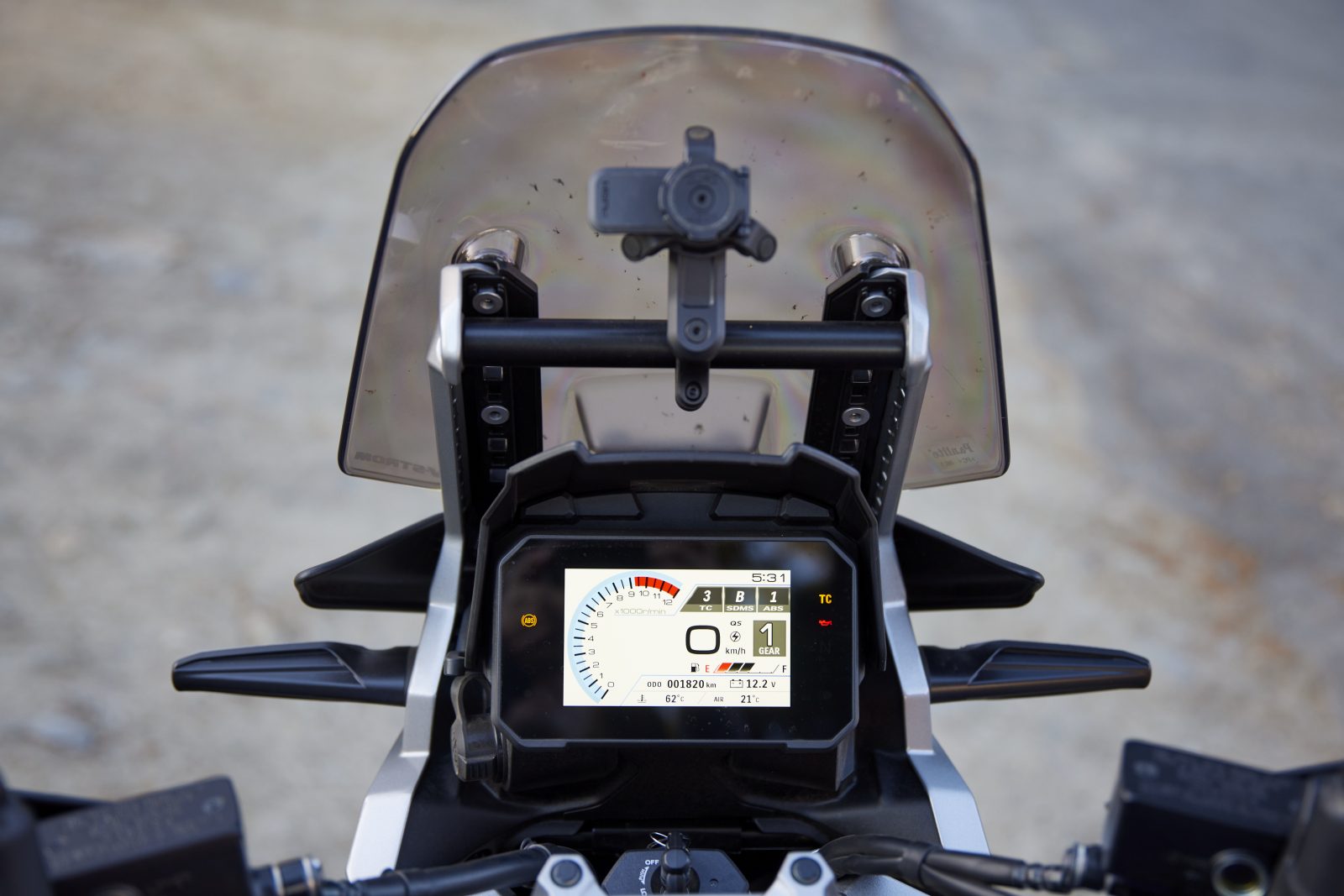
Yes, the 1050DE is better than any V-strom before it off-road, but it’s still heavily comprised by a few factors – with weight the biggest. The V-Strom is a hefty 252kg (wet, claimed) and a lot of that weight feels like it’s held quite high. It feels dauntingly top heavy and, with a seat height of 880mm, short riders need not apply (isn’t that right, Deano?).
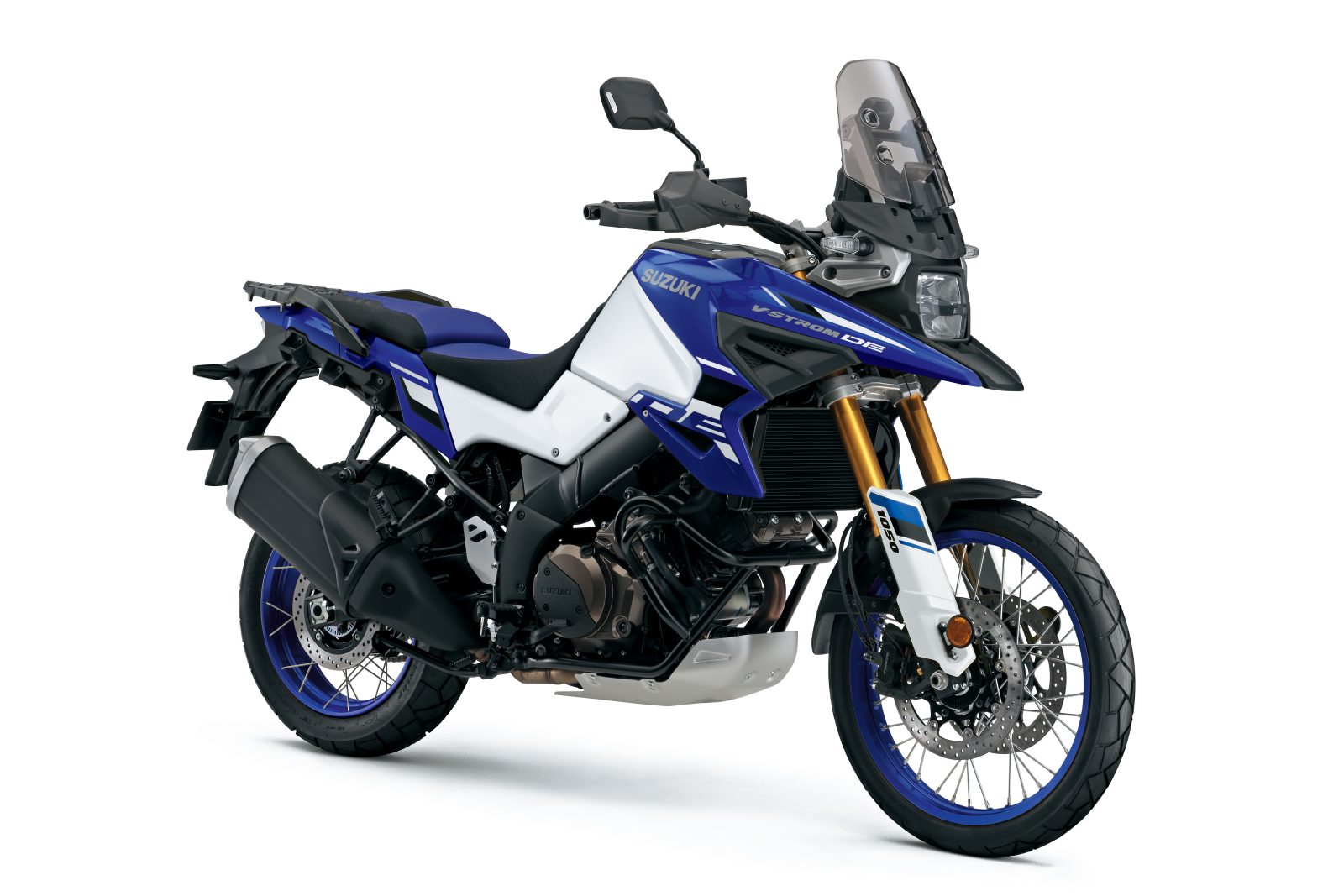
BMW’s R 1250 GS, considered by many to be the heavyweight of the class has a claimed wet weight of 249kg, three kegs less than the Suzuki. The sheer mass compromises rear suspension performance meaning the ’Strom really struggles trying to power out of heavily corrugated dirt corners. The front suspension handles off-road conditions better and, in the Suzuki’s defence, the suspension works beautifully on road alongside the balance of the package.
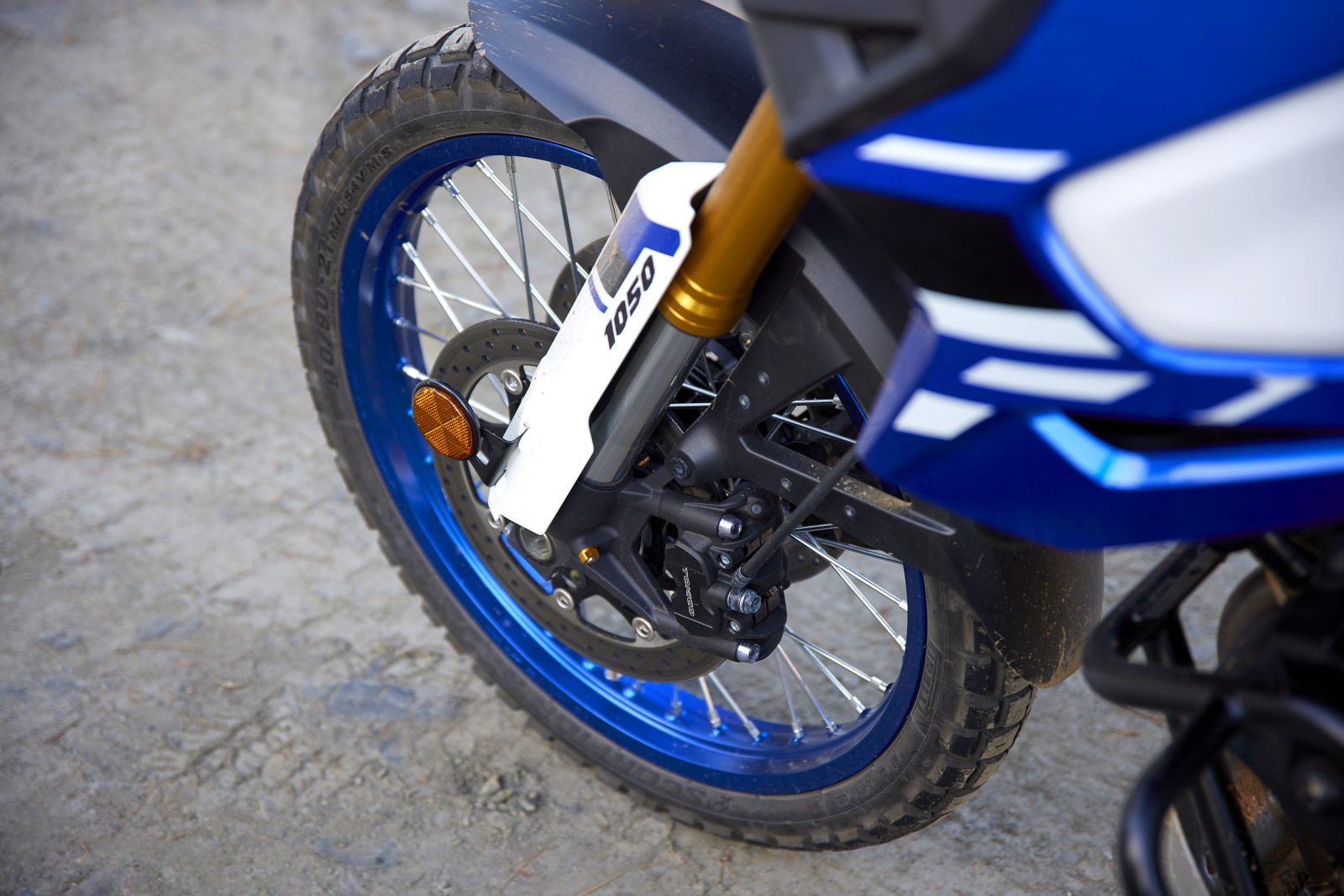
The other area of compromise is ergonomics. The standard bum-on-seat road-riding position is spot on, but when off-road riding calls for standing, the V-Strom feels wide and awkward; if you remain seated off-road you sit so far back there’s very little chance of weighting the front wheel. The twin-spar aluminium frame is terrific on tarmac but it’s too much of a compromise for Suzuki to ever turn the 1050 into a serious off-road adventure contender.
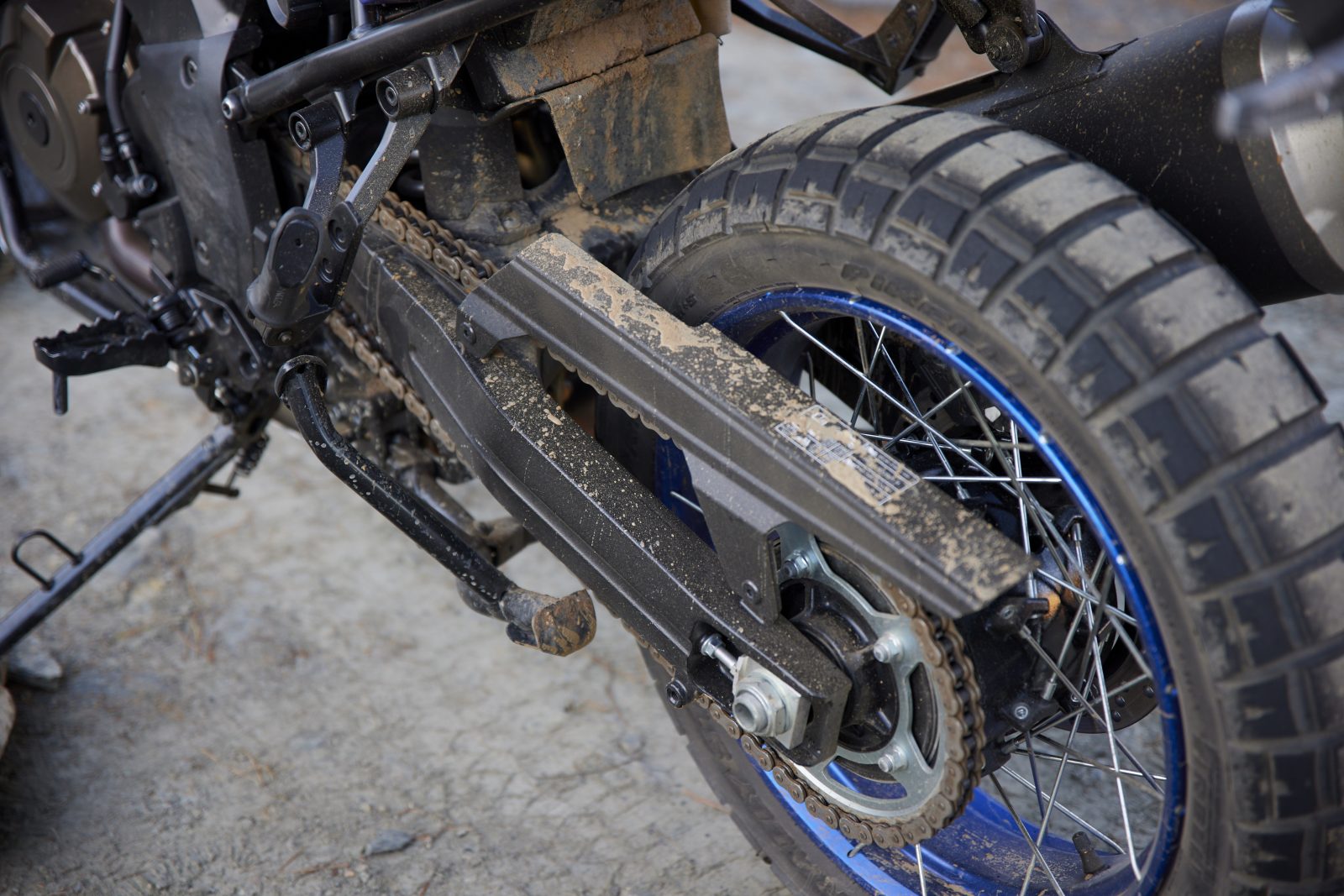
The beauty of the 1050XT variant is its ride away price of $21,990 and, although it lacks off-road prowess, it is an awesome adventure tourer at a great price. The 1050DE, however, has a ride away price of $24,690 which means it’s not a whole lot cheaper than the KTM, Ducati or Triumph and those three are better off-road and, in my opinion, just as good on-road.
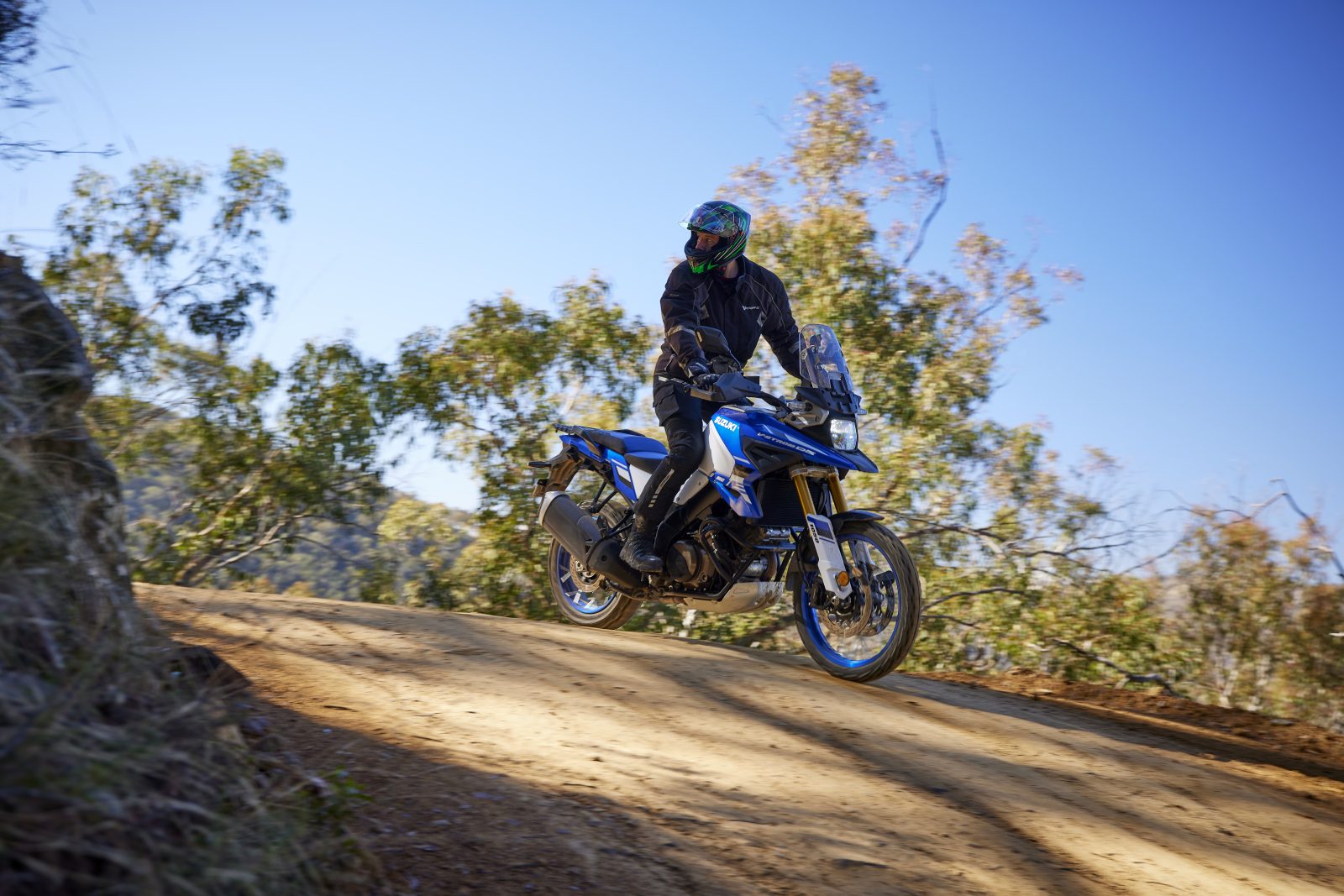
With that said, the V-Strom went everywhere the others went, so you can choose to take the road less travelled if you have a good grasp of off-road riding… and long legs.
Pete Vorst
SECOND OPINION
I loved the V-Strom on the dirt. It’s the first time I’ve ever said that! I preferred other bikes on this test but the V-Strom’s capability surprised me. The only limit I hit was the rear shock, so given the price you could justify the spend to sort it out.

I’m fussy about things like how my knees grip the bike, how adjustable the levers are and whether I can get forward when accelerating and not be decapitated by the screen. Tick, tick and tick. The engine, brakes, throttle response and standing and sitting position are all excellent. I even like the limited electronic controls: basic and easy to understand. Love that.
Josh Evans
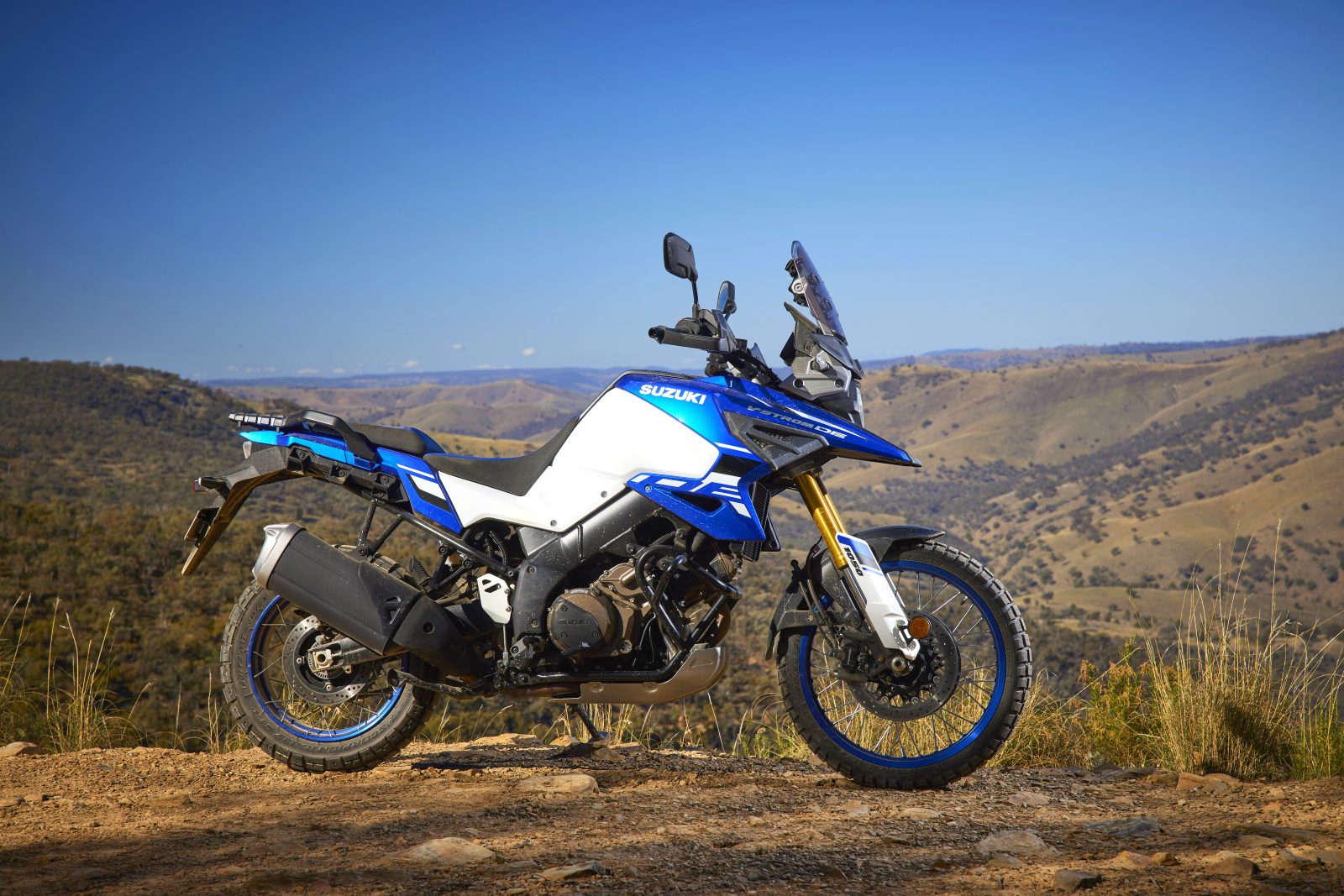
Triple treat – Triumph Tiger 900 Rally Pro
As all-rounders go, the Tiger is nearly as good as it gets. And with stacks of fruit, it represents excellent value
The Triumph Tiger Rally Pro will set you back $25,450. That’s a fair bit of coin in anyone’s eyes but at that price it’s within a few hundred bucks off the KTM, Ducati and Suzuki, and just a few grand more expensive than the Aprilia. But you get a lot of standard kit that you’d need to pay extra for on some of the others: a centrestand, crash bars, alloy bash plate, quickshifter, tyre pressure monitoring, heated rider and pillion seats and LED fog lights.

Plus you get the beautiful 888cc triple that’s packing 70kW (94hp) of power and 87Nm of torque, fully adjustable Showa suspension, Brembo brakes and the gateway to the impressive tech package, a seven-inch TFT dash – serious bang for buck.

Unfortunately, both on road and off-road, the Triumph Tiger 900 Rally Pro’s performance was held back by the rubber fitted. The Tiger comes standard with Bridgestone Battle Wing tyres which have more of a tarmac focus – and the hoops on our test unit were already used and abused, with the rear almost worn flat in the centre.

A shame because the Tiger is a capable machine and has pedigree, with five-time enduro world champion Iván Cervantes winning the 2022 Baja Aragón trail category on the 900 Rally Pro. Victories like that don’t come on a whim.
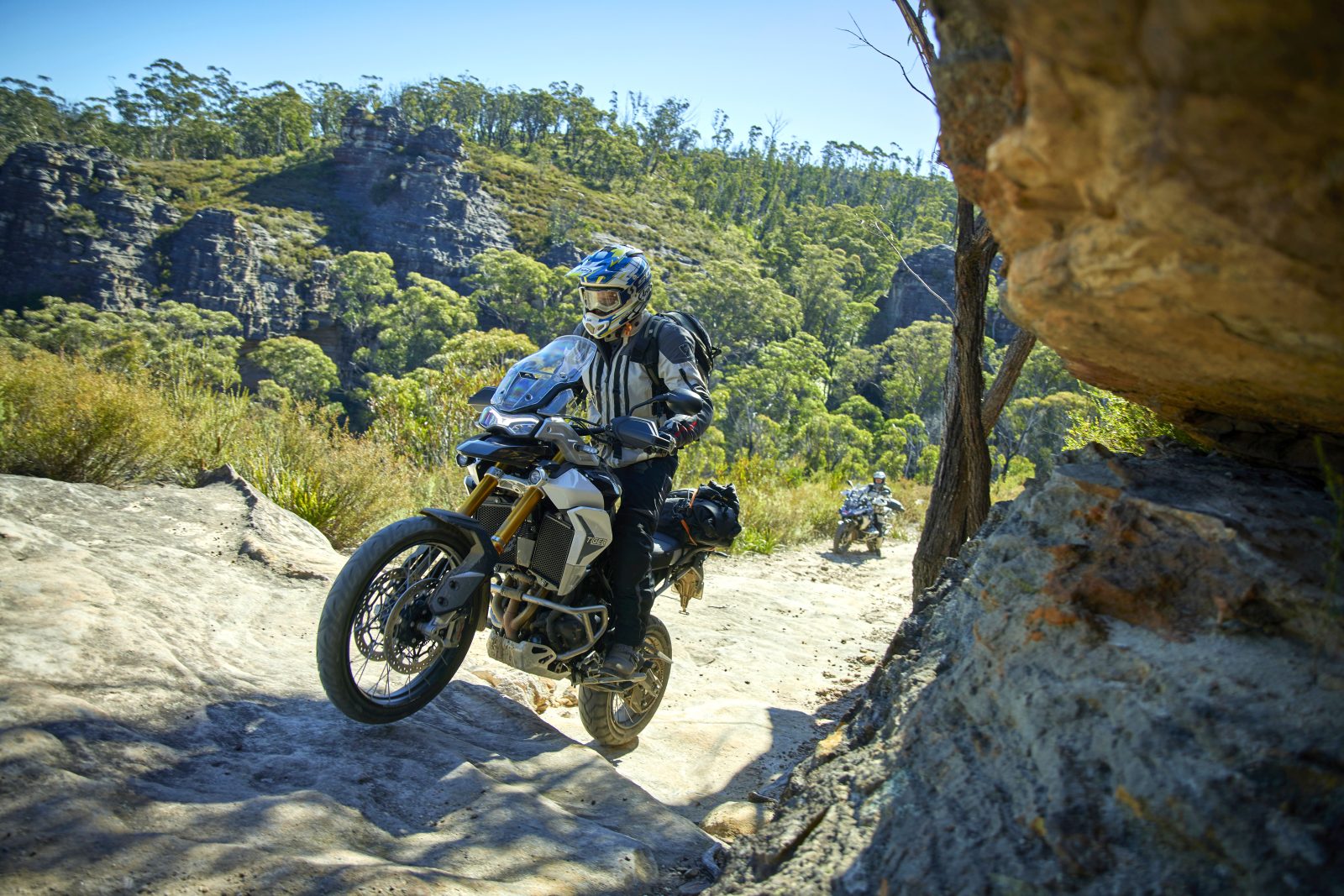
That said, in situations where you’re not leaning heavily on grip, like fanging along a dirt road or launching off a contour drain, you realise that there’s an adventure bike underneath you that is seriously capable off the beaten track and is an excellent tourer.
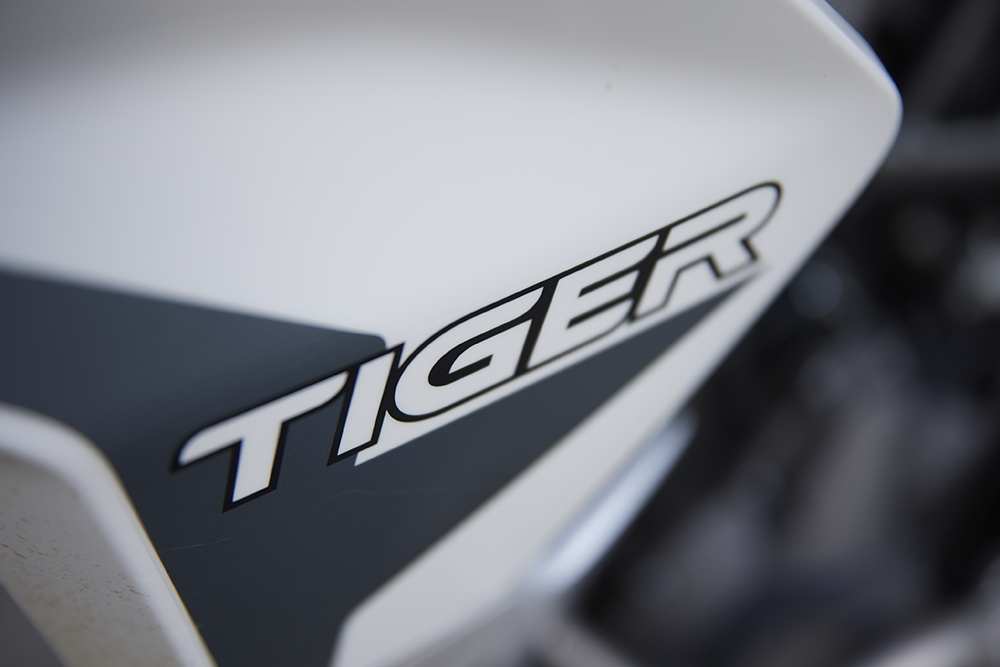
The fully adjustable Showa suspension offers 240mm of travel at the front and 230mm on the rear, with an action that is plush without being too soft for attacking off-road sections.

The Tiger weighs in at a claimed 201kg dry, which is pulled up by Brembo Stylema calipers gripping twin 320mm discs – top-shelf stuff. Unfortunately, the front brakes didn’t feel great, which is just not the way Brembos usually work, so we can only assume the testbike had copped a bit of a flogging before it got to us.
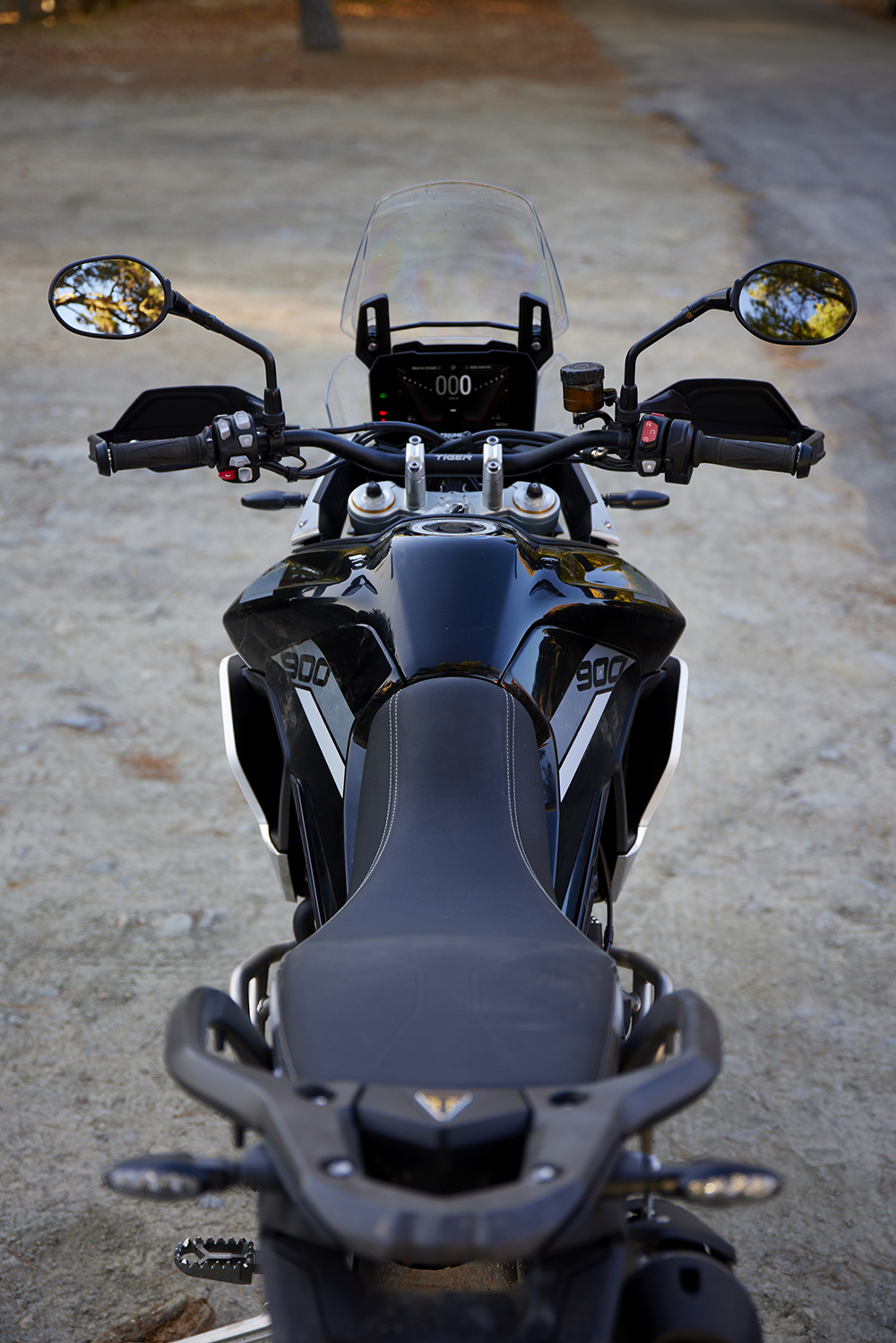
That aside, the Tiger has typically excellent Triumph ergonomics and it’s supremely comfortable – you could sit on the thing until the 20-litre tank is empty without getting too sore an arse. Moreover, the combination of a skinny waist, wide footpegs and reasonably high ’bar results in a comfortable and natural feeling when standing.
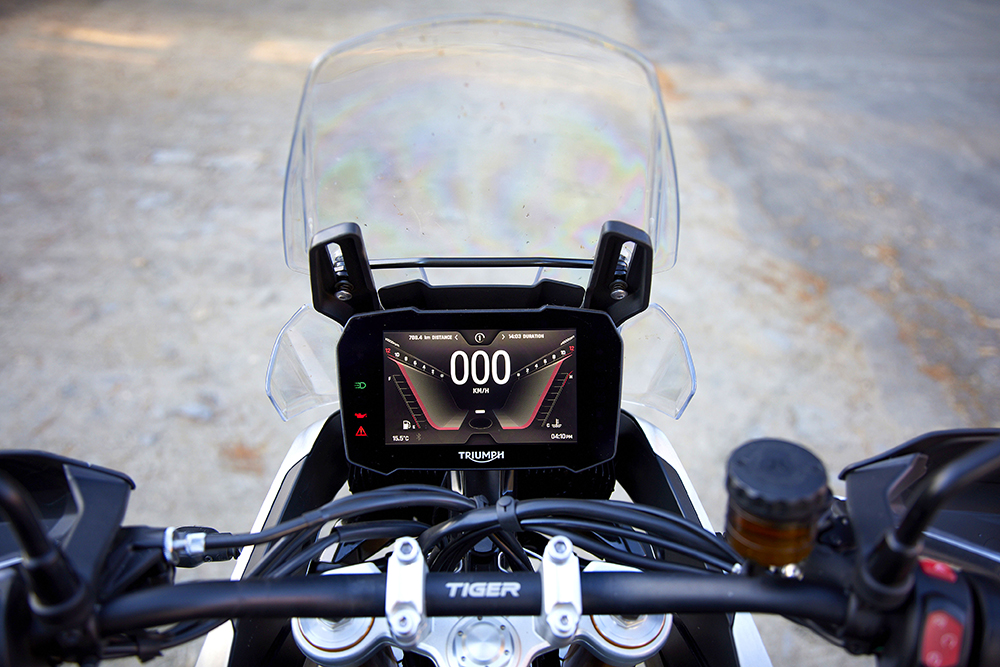
Out of the group, the Triumph isn’t the best at any one thing but finds a happy place in being a really good all-rounder – maybe even the best all-rounder here. I have no doubt it would have shined with better off-road rubber fitted, and I’ll be pushing Triumph to get us another testbike soon so we can revisit it.
Pete Vorst
SECOND OPINION
The Tiger 900 Rally Pro is another bike I’d been hanging out to ride after hearing nothing but praise from those who have sampled it. On the road I loved the Trumpy’s potent inline triple, the well-balanced chassis, the nicely sorted suspension and the all-round comfort. The technology package is impressive too, and the big TFT screen bright and easy to read.

Off the road it was another story; with used road-biased rubber, no one was keen to be on the Tiger in the slippery, sketchy sections – there simply wasn’t enough grip available to get comfortable, let alone really feel what the bike was capable of. I’m looking forward to another ride on the Tiger 900 as soon as we can organise it.
Dean Mellor
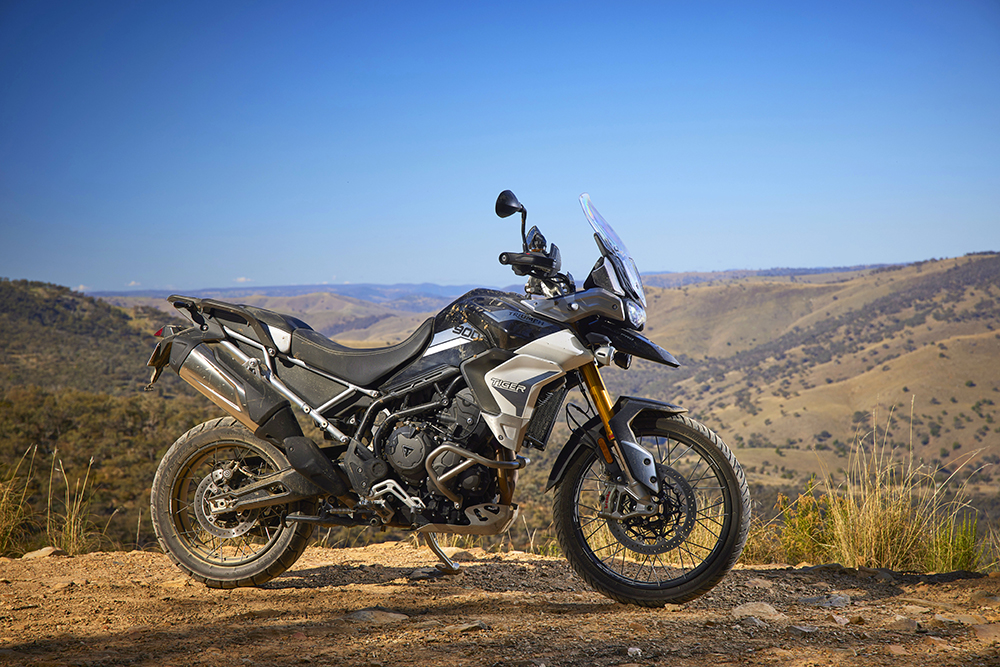
Horses for courses
Newcomers, stalwarts, high-tech and superb simplicity…
The adventure bike market continues to grow with more manufacturers producing more models than ever before… including a couple of big-hitting midsize machines that have just arrived on the market: Honda’s new XL750 Transalp and Suzuki’s new V-Strom 800DE.
While we left more bikes out of our 2023 adventure bike test than we included, we ended up with a good cross-section of machines that span the genre, from the Aprilia 660 Tuareg to the big-bore BMW R 1250 GS – some all-new models we haven’t tested before to some that we are very familiar with.

But what about the Yamaha Ténéré 700, you ask? Or the Kawasaki KLR650? Or the Moto Guzzi V85TT? Or… There is no doubt there are plenty of other bikes that deserve to be included in any adventure test, but the seven bikes here made the cut partly because they are some of the most recent and impressive machines on the market, and partly because they were available at the time we needed them. We also thought it was only fair that we accepted a maximum of one bike from each manufacturer.

While the idea behind this test is not to pick an overall winner, there are certainly some bikes that work better in some scenarios than others. For example, the best off-roaders here are the KTM 890 Adventure R and the Aprilia Tuareg 660, closely followed by the Ducati DesertX. The best long-distance mile eater is the BMW R 1250 GS Trophy, closely followed by the Triumph Tiger 900 Rally Pro and the Suzuki V-Strom 1050DE.

And the best value adventure bike – that is still packed with tech and features, mind you – is the CFMoto 800MT Explore; it’s literally half the price of the R 1250 GS Trophy.
The bike you choose as your next adventure companion will be dependent on many factors, including the type of riding you intend to do with it, whether you are riding solo or with a pillion, and what your budget is and what you consider important in a motorcycle.
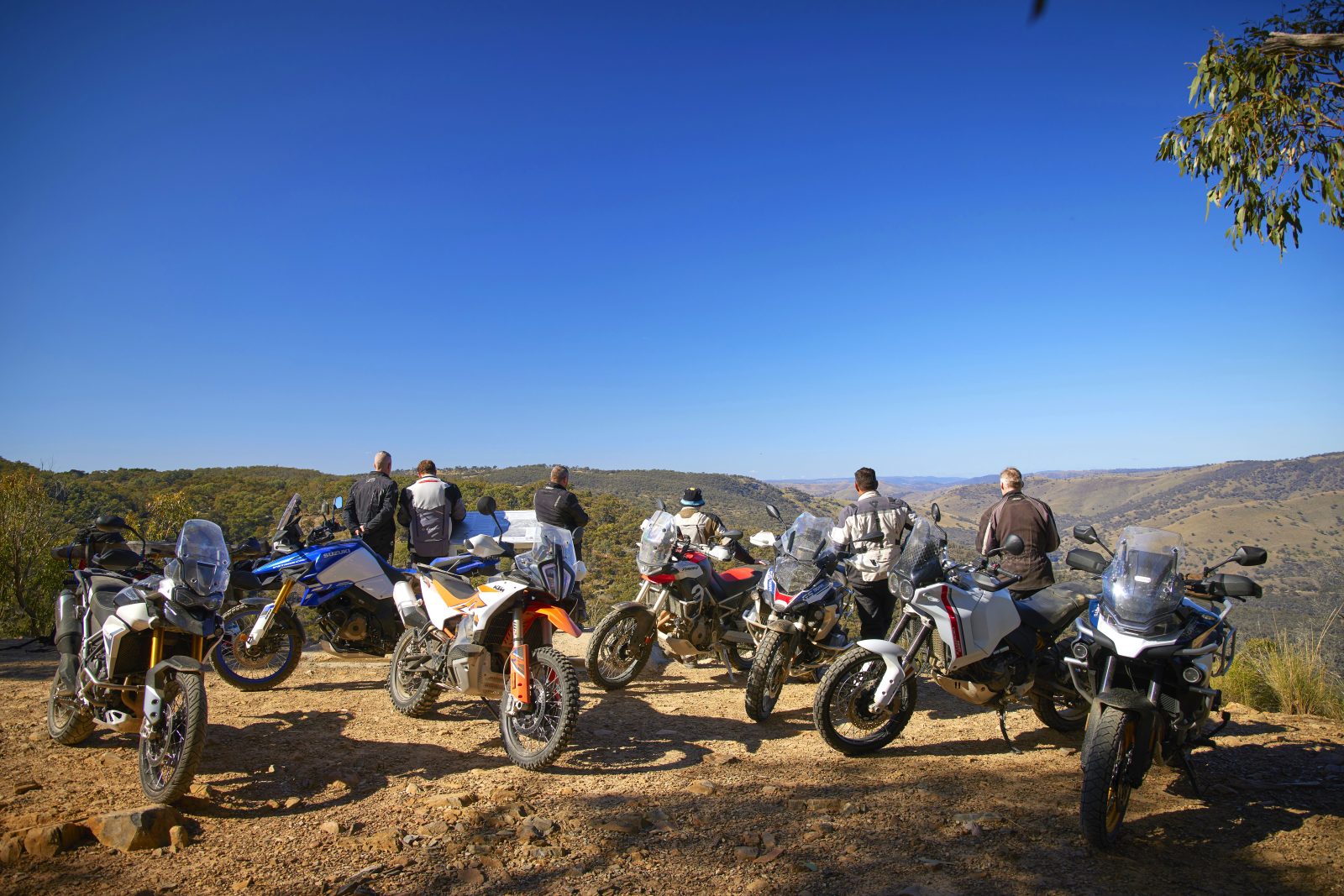
If you choose any one of these seven bikes, we have little doubt you’ll be a happy camper, because all of them came through our 2023 adventure test with flying colours.
Finally, keep an eye out for a comparison test between the XL750 Transalp, V-Strom 800DE and the Ténéré 700 in an upcoming issue; we’ll get a hold of these three as soon as we can.
In the meantime, happy travels…





